There’s a lot that makes Auckland unique. It’s the only major city I know of that’s situated on an isthmus (with the Tasman Sea to its west and the Pacific to its east). It’s one of few major colonial cities that not only acknowledge its indigenous culture (the Maōri) but actively uses its language and promotes its education.
But during the course of my research, one that caught my eye were the volcanoes of Auckland.
This is a trip report of a tour I took around Auckland, to see many of its major volcanoes, on February 4th, 2020.
Planning
Because my trip to New Zealand happened only 3 weeks after my Thailand-Myanmar trip, I didn’t have much time to plan. The only thing I knew for sure about this trip even a week in advance was that I was going to explore Auckland for a few days, join up with a local friend (Jenny) for a drive down to Rotorua, run the Tarawera 102K ultramarathon on Saturday, the 8th, then fly out to Queenstown on Sunday to begin a 6-day cycling trip on Monday.
So what to do with my time in Auckland? I wanted to keep planning to a minimum, so I looked for full-day tours. And lo, there was a full-day tour specifically to look at the various volcanoes around Auckland.
Its name: “Full-Day Grand Auckland Volcanoes Tour.”
Its description: “Auckland is known as the City of Sails, but some think it should be called the City of Volcanoes! Gain insight into Auckland’s unique volcanic geology and explore its rich Maori history on this full-day tour from Auckland.“
This tour would basically hit up all the spots I wanted to visit, including all the touristy spots like Mt. Eden and One Tree Hill, while giving me a chance to learn more about Auckland, its locals, and its history from a native.
Meeting Up
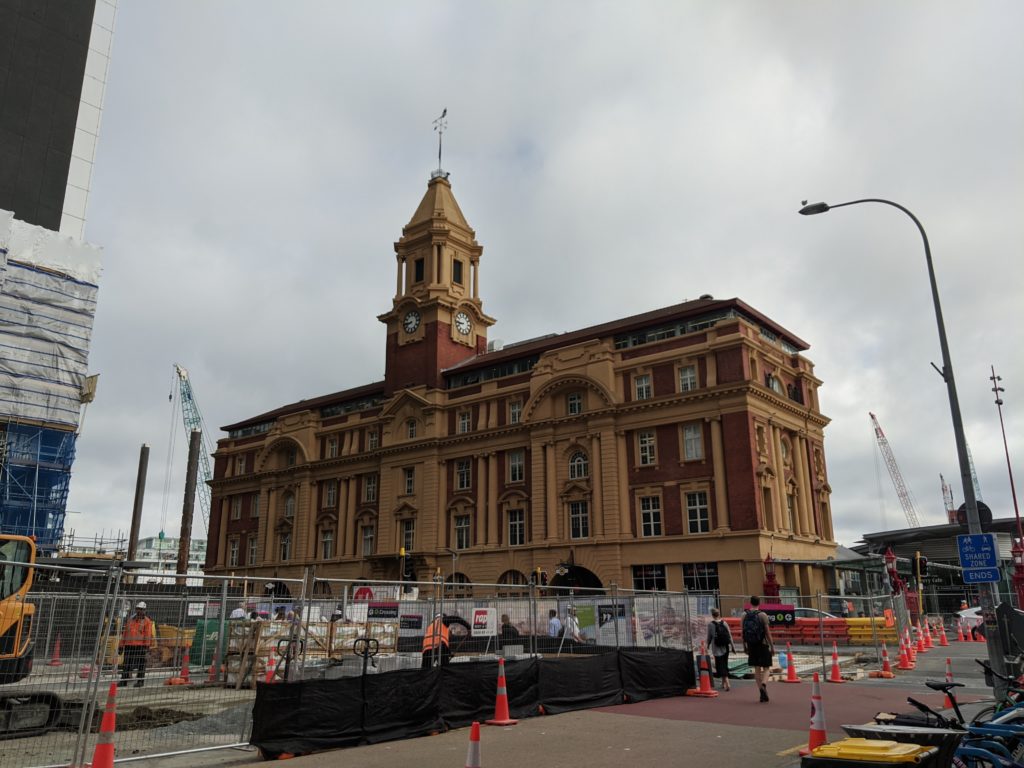
The first thing I had to do, of course, was meet up with the tour operator. When I booked the tour, the only thing I knew about the operator was its name: Voltour Limited. I didn’t know how large it was, I didn’t know how many people to expect in my group, and like any tour, I didn’t know what the guide would actually be like (and for sure, I’ve had some great guides, and some downright terrible guides).
As I waited near the Ferry Terminal at a building hidden amidst construction for Auckland’s new subway system, a man came up. After a few seconds, we both asked each other if we were there for the volcano tour.
As it turned out, this man would be my guide today. Only one other person would be joining us, a woman, for the first half of the tour. Then it would just be me and the guide in the afternoon.
Volcano 1: Rangitoto
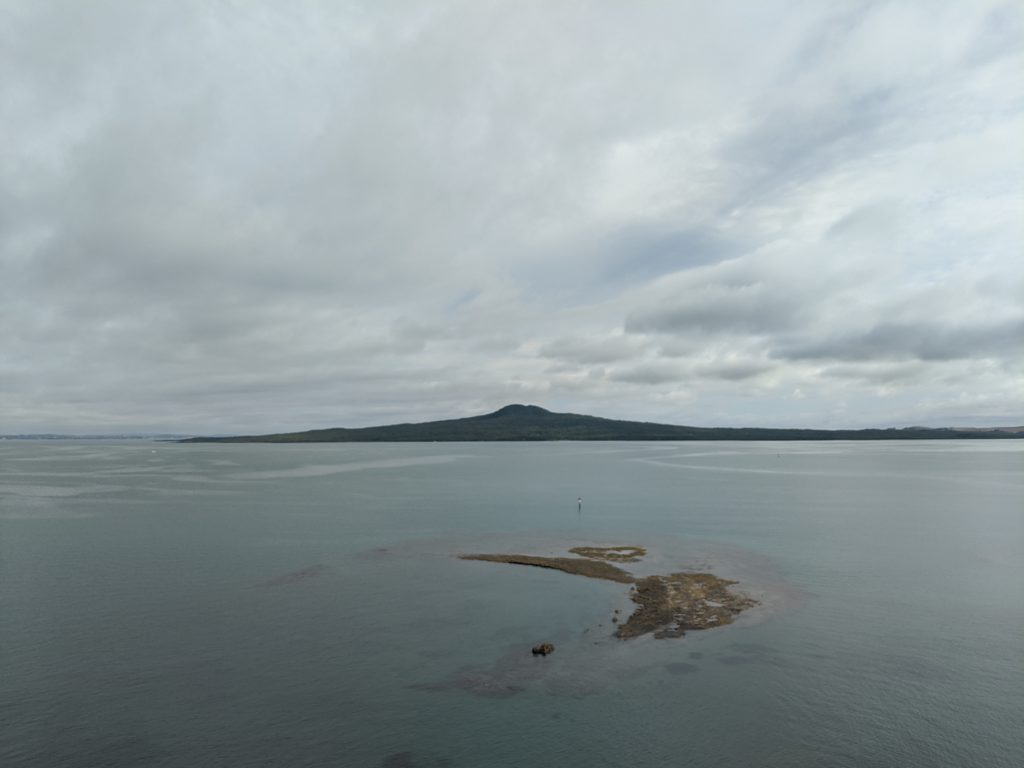
Our first stop was Achilles Point (or Te Pane o Horoiwi, meaning “The head of Horoiwi”). Here, we had a scenic view of Rangitoto Island.
On either side of the wooden lookout, we also saw Ladies Bay to the west and Gentlemens Bay to the east. Part of Brown Island was also visible to the east.
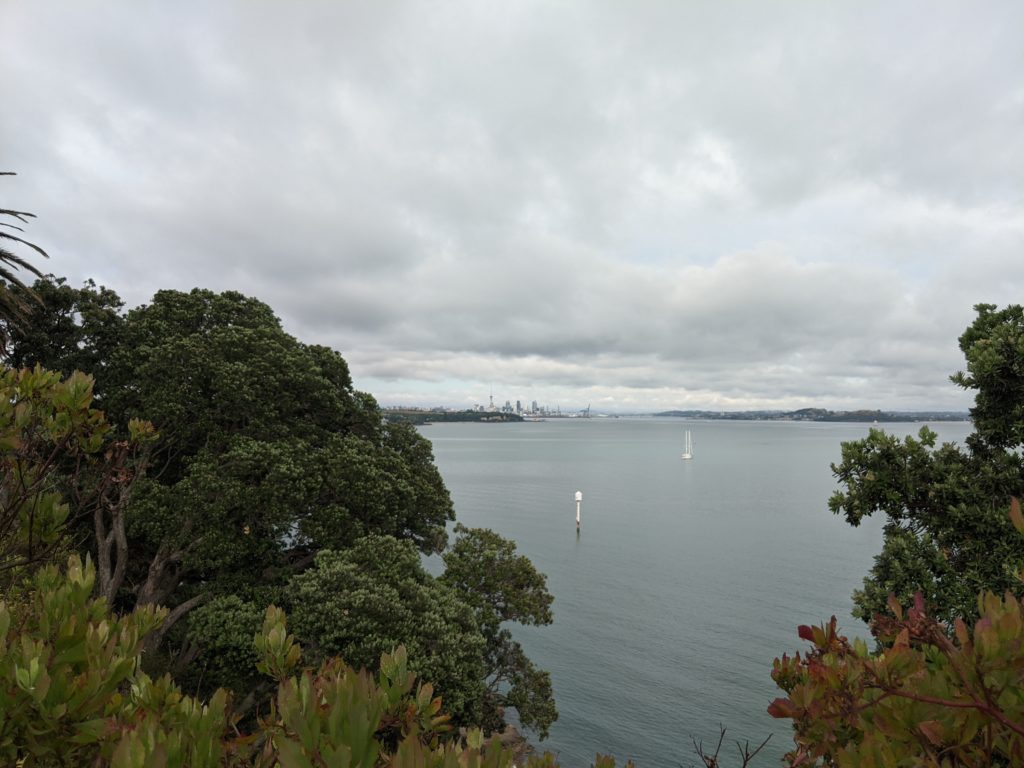
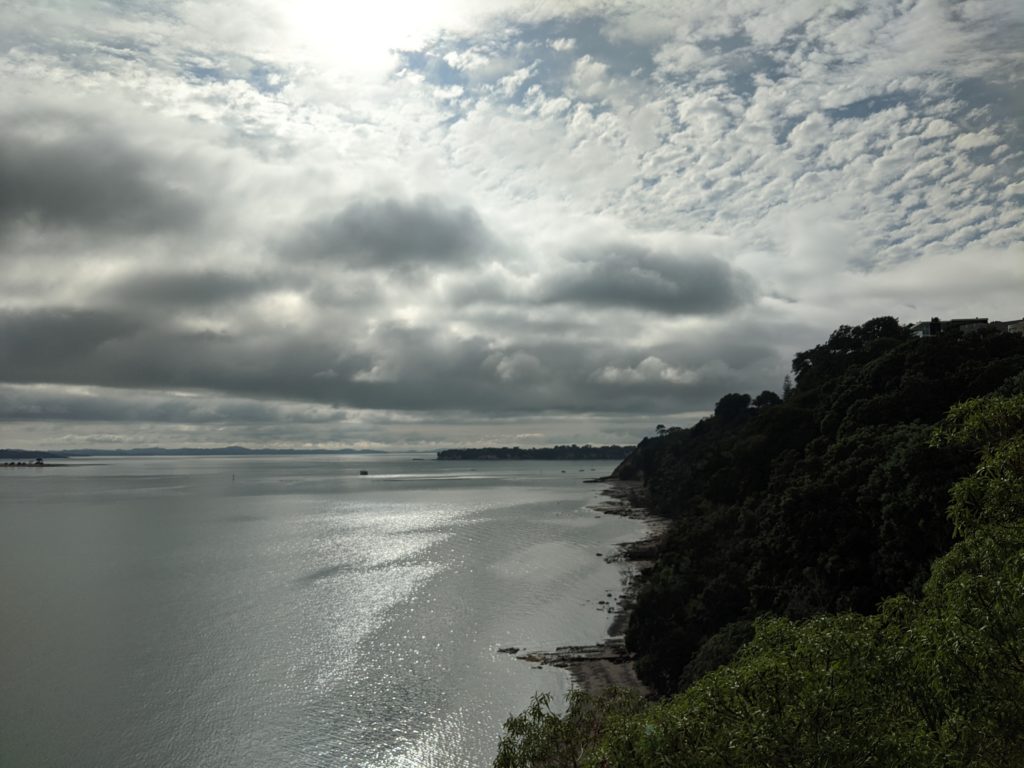
Rangitoto, as Michael, my guide, explained is the youngest of all volcanoes in the Auckland volcanic field, erupting just some 600 years ago. It’s also the largest. Here he gave my fellow tourist, a young Australian on a working holiday, a quick overview of the landscape of the Auckland volcanic field. In short: there’re over 50 volcanoes in and around Auckland! None have ever erupted more than once; they’re all considered extinct. The field itself is considered dormant, but could easily become active once again. If that such an eruption were to occur, though, it would be mean catastrophe for the 2-plus million residents of Auckland, as well as New Zealand (Auckland accounts for some 40% of both the country’s overall population and GDP after all).
As we left, we also took a quick look at a few Maōri pou whenua (land posts), Taikeh et Hotu. I don’t recall if there was any particular importance of these sculptures being here.
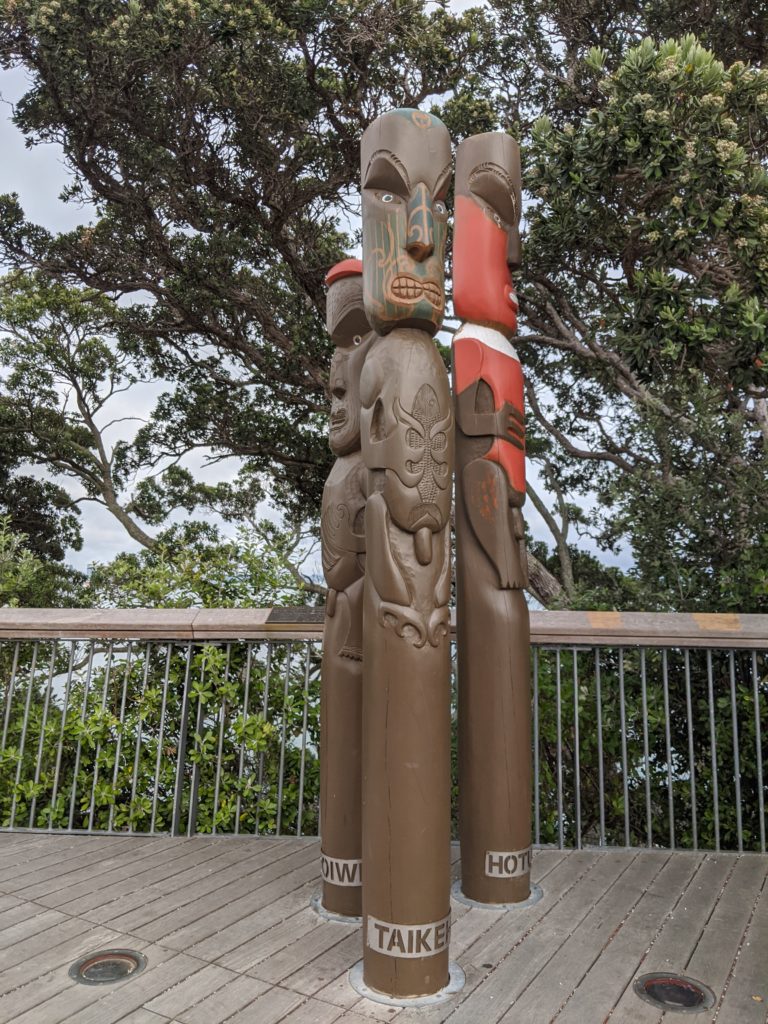
We also passed by Grover Park as we left. To my untrained eye, it looked like any other standard urban park. But I learned that it’s actually an 160,000-year-old volcanic “explosion” crater that turned into a swamp, that was subsequently drained then filled in during the 1950s.
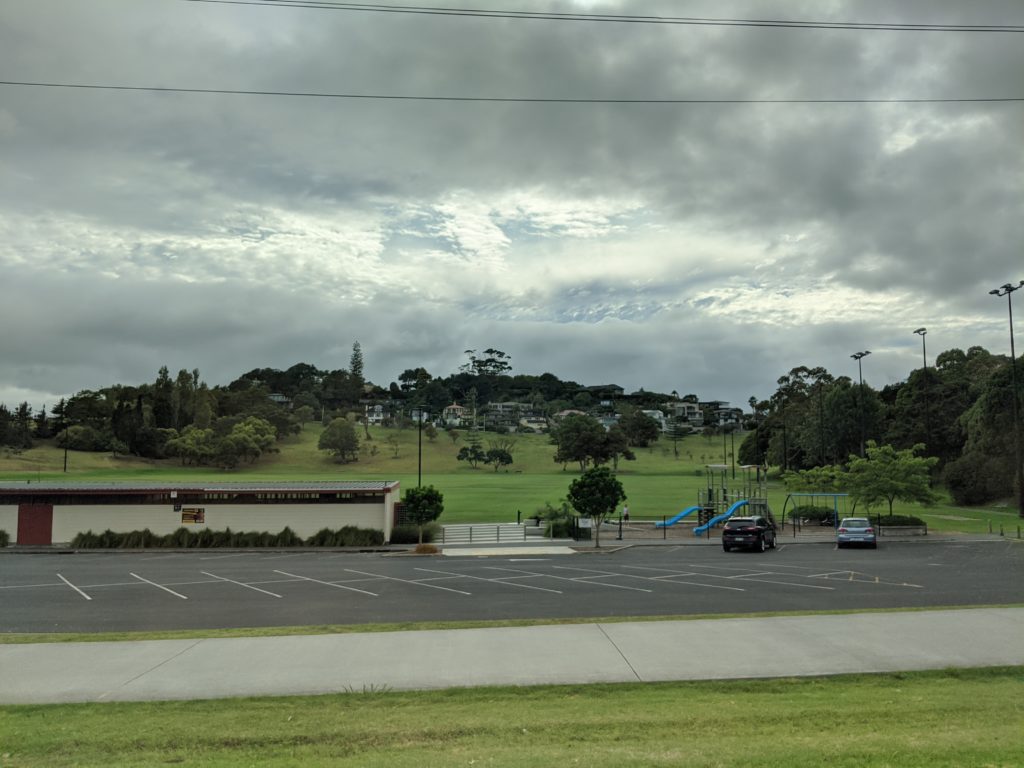
Volcano 2: Mount Wellington / Maungarei
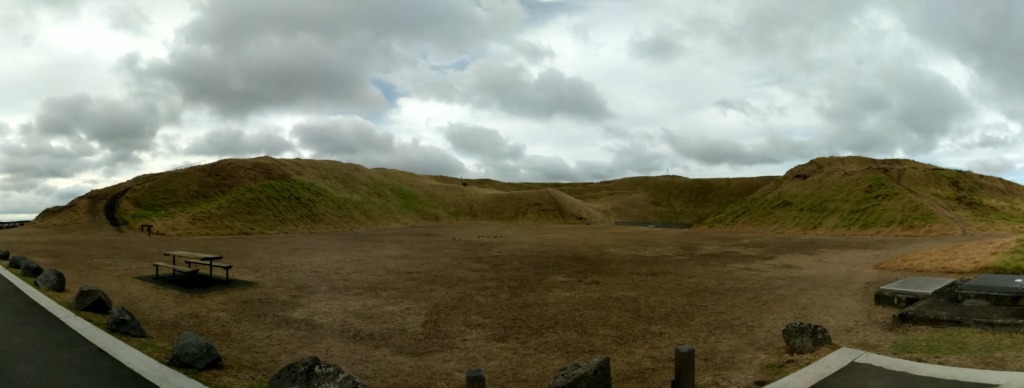
Our next stop was Mount Wellington, also known as Maungarei (or “watchful mountain”).
As we hiked up the (relatively short) mountain, Mike explained that Mount Wellington erupted about 10,000 years ago, making it the 2nd youngest volcano in the Auckland field.
He also pointed out a long trail of small, white fragments that crunched underfoot as we walked. “Do you know what we’re stepping on?” he asked.
“They’re seashells!” I answer.
“We’re miles away from the ocean. Why would there be seashells here?”
I guess that perhaps this mountain was once under the ocean. Or maybe the water had come up as high as we were on this peak.
“It’s trash. Māori trash from centuries ago. This used to be a pā, or Māori hillfort.”
As we continued to walk toward the crater, Mike pointed out where the pā’s fortifications might’ve been. There was probably a wooden palisade here — or there. As we passed the eastern side of the mountain, a terrace here — or there — might’ve been someone’s home, or possibly small farm. Notably, we also passed by small mounds of dirt, where Mike once again peppered me and my fellow tourist with questions; these mounds were food pits. (I actually guessed this one right! It seems like keeping food cold underground is a common theme among cultures worldwide before the advent of electric refrigeration.)
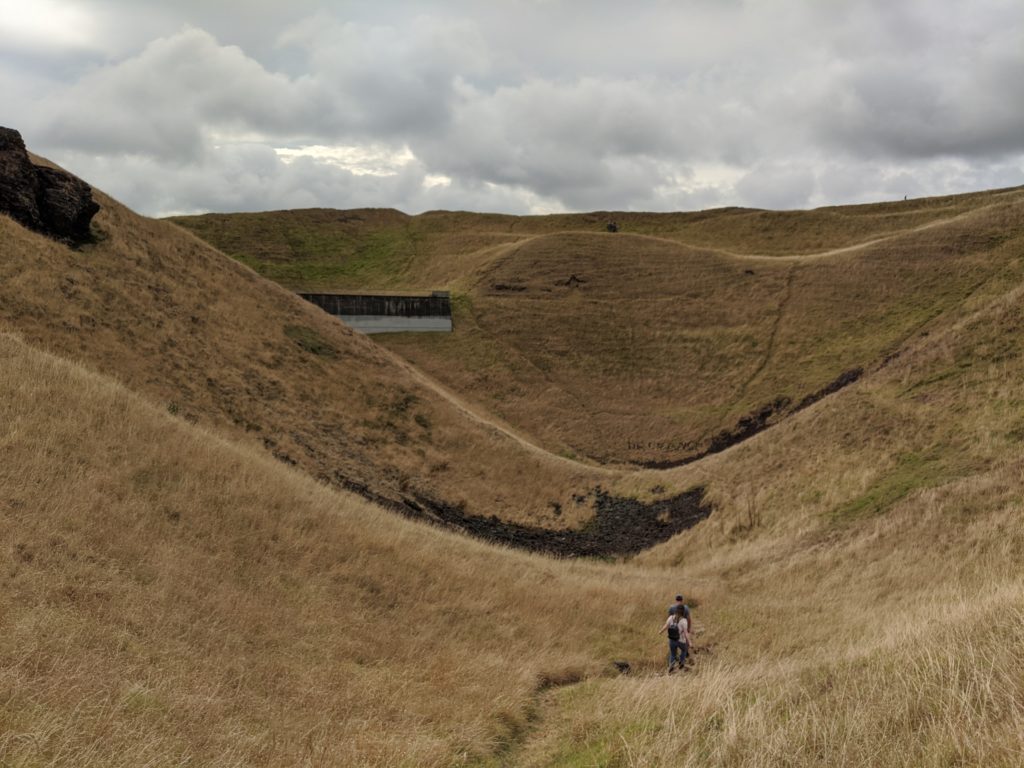
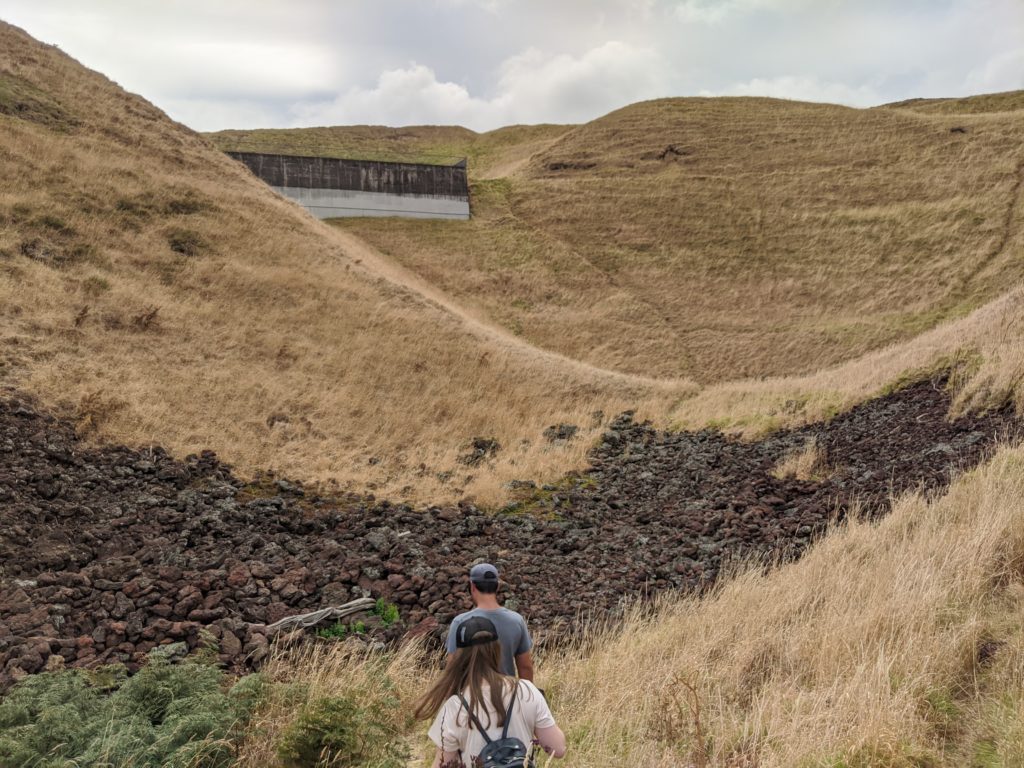
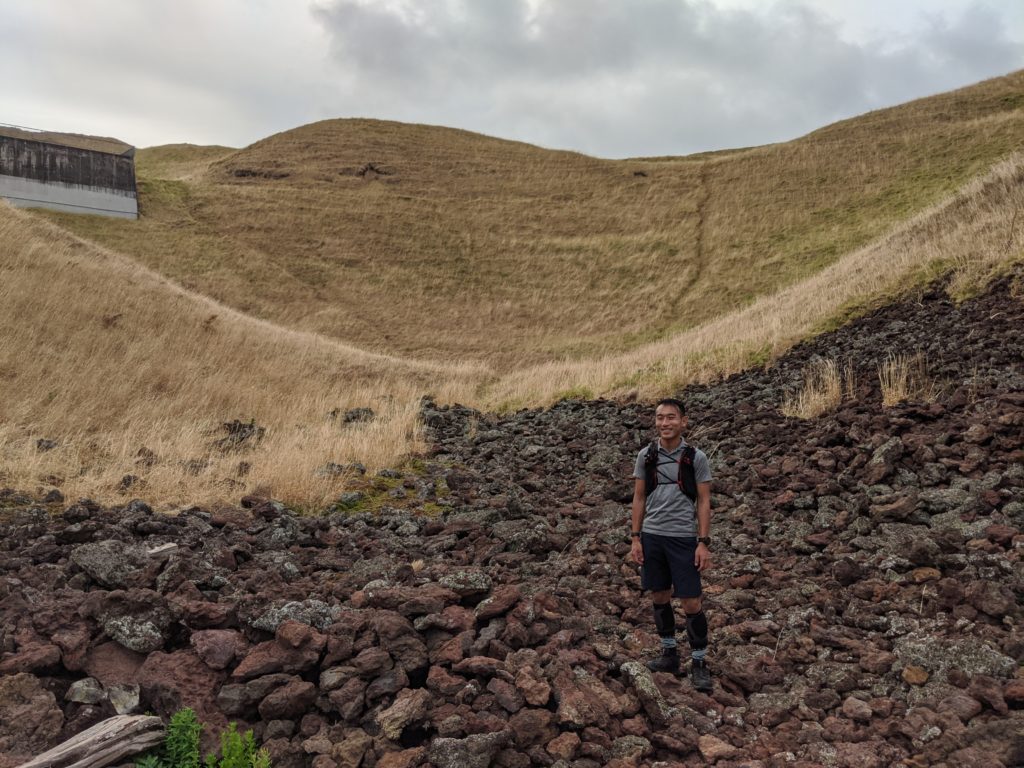
As we entered the crater, I was surprised to see a field of rocks. These weren’t ordinary rocks. They had bubbles!
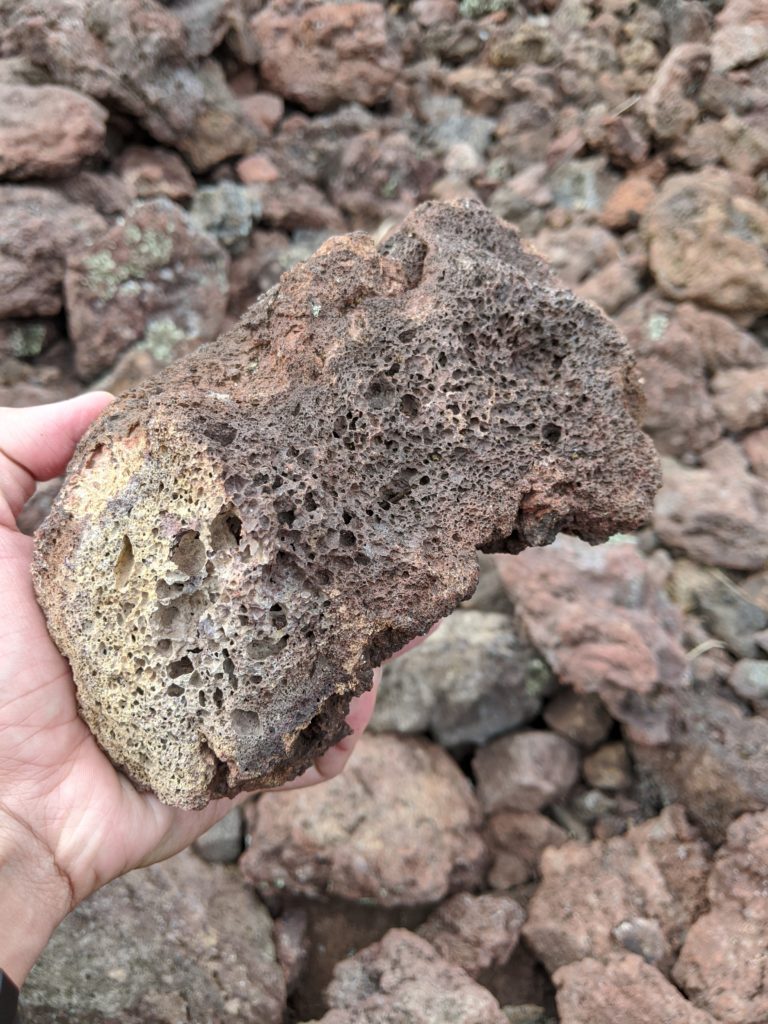
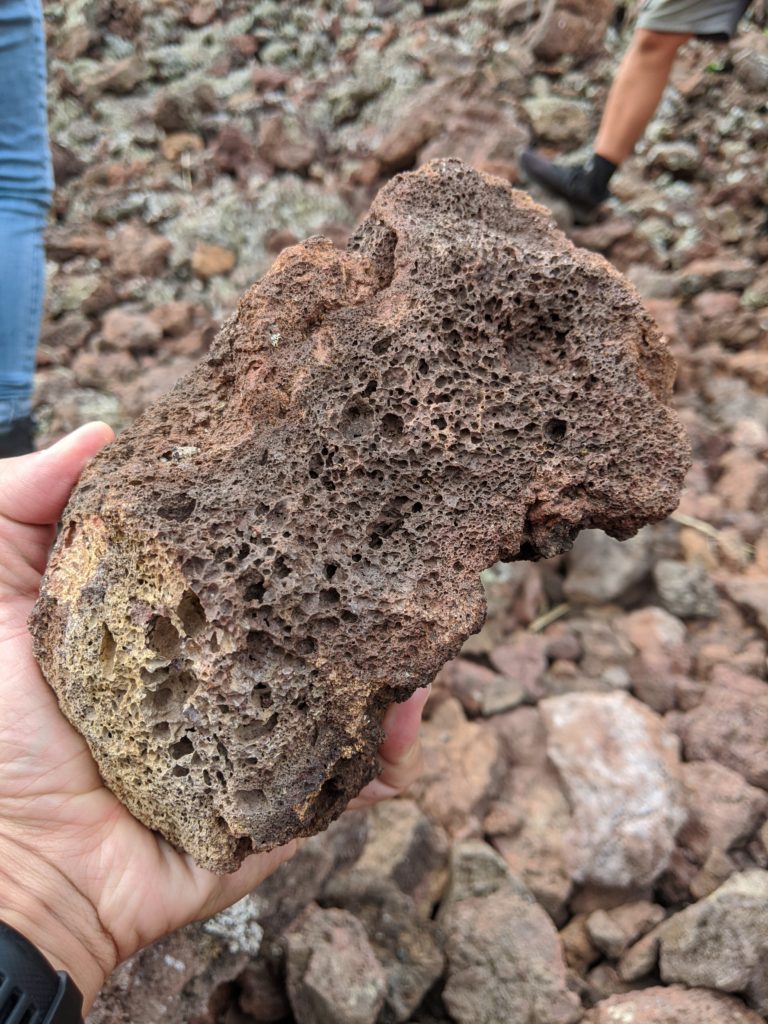
These were scoria cinder cones, Mike explained. Before this volcano erupted, its magma contained dissolved gas. When the volcano erupted, molten rock was thrown out by the pressure of the gas. As these rocks began to solidify, gas previously trapped within was released. The small cavities in these rocks was where gas had lived before bubbling to the surface. (Simple!)
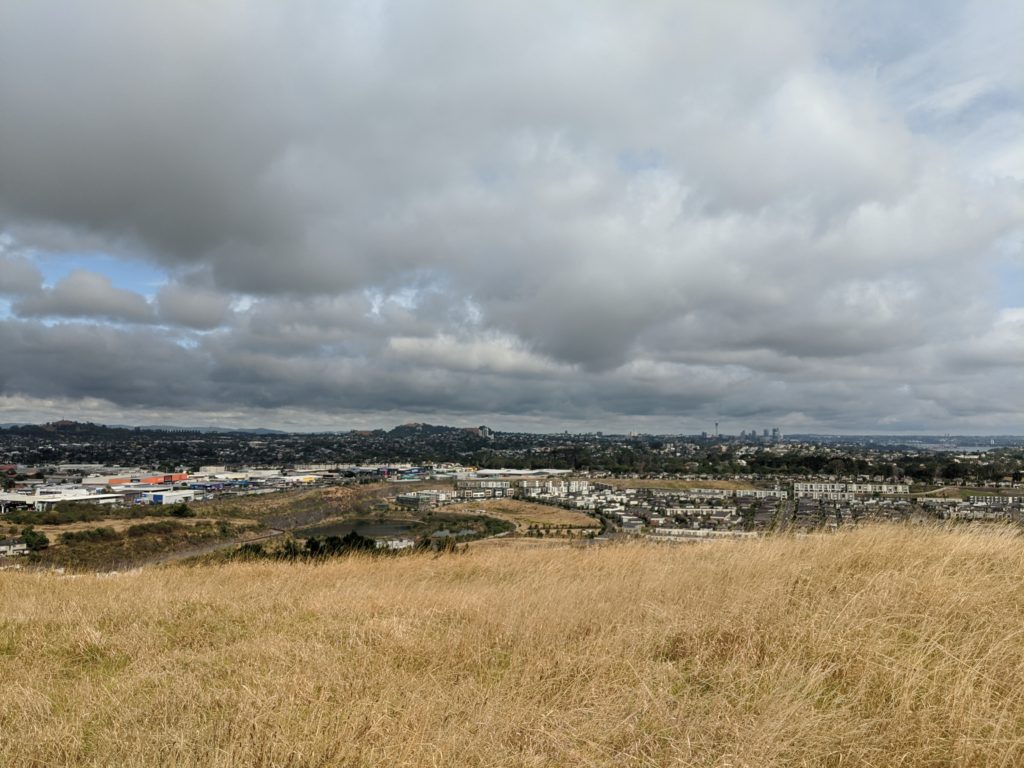
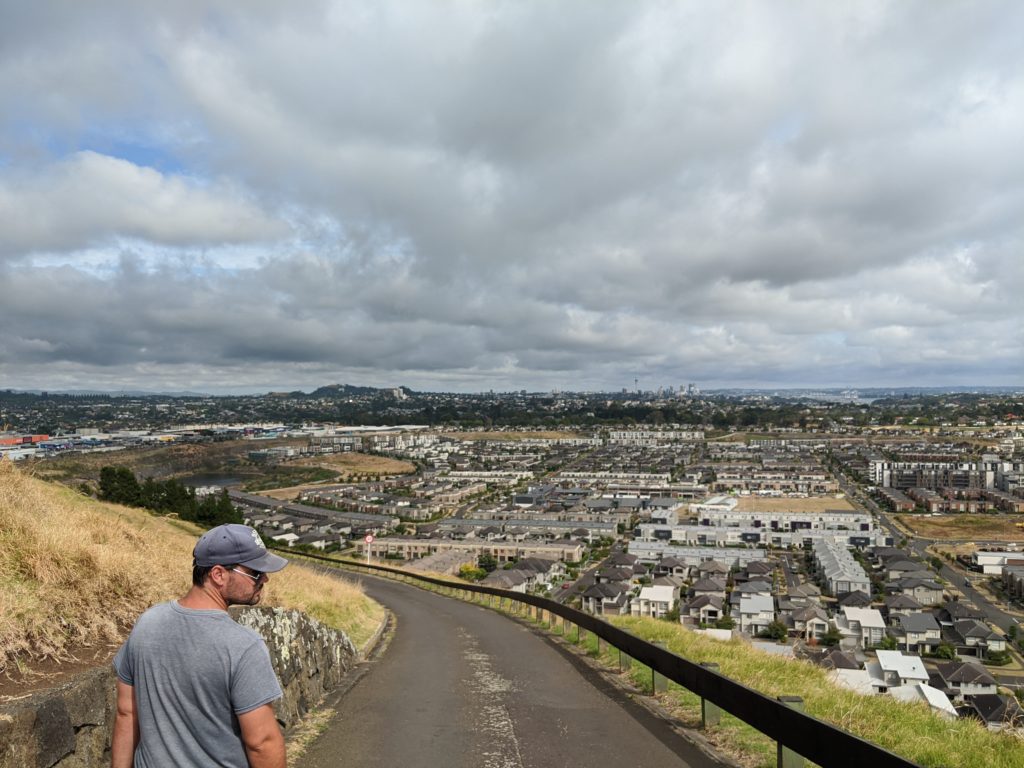
As we headed down from our first volcano, Mike pointed out a nearby housing development and the pond nearby. These houses looked new; they also looked like cookie-cutter houses.
“This used to be a quarry,” he said. “It provided rock for a lot of New Zealand’s roads.”
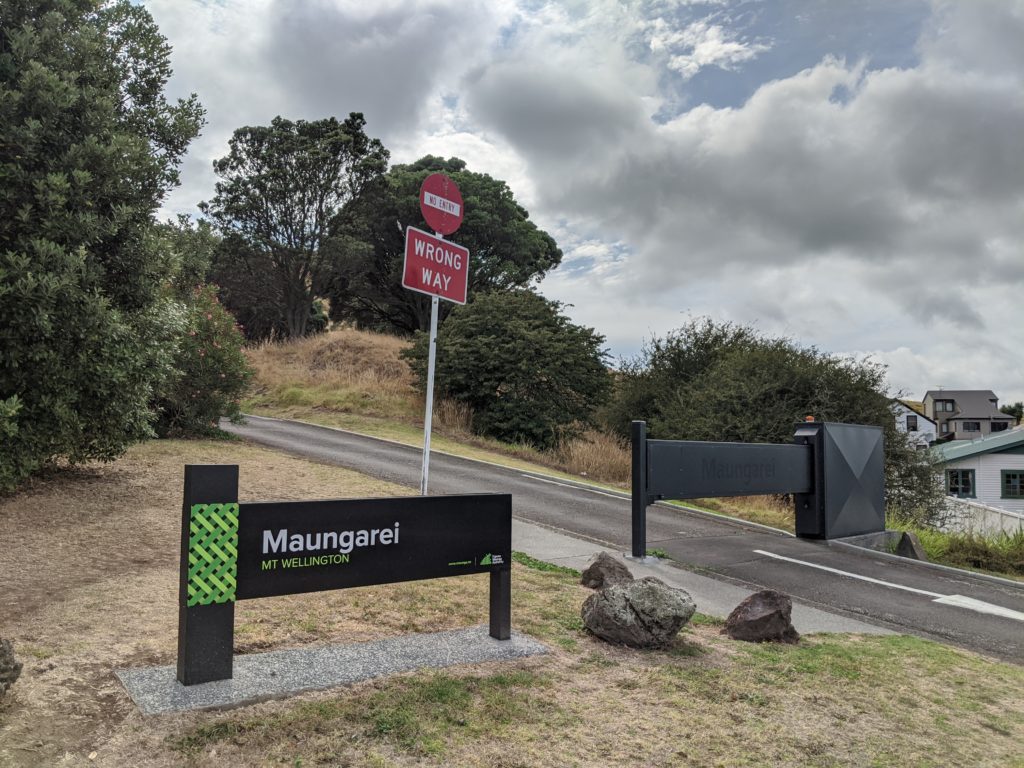
Volcano 3: Māngere Mountain
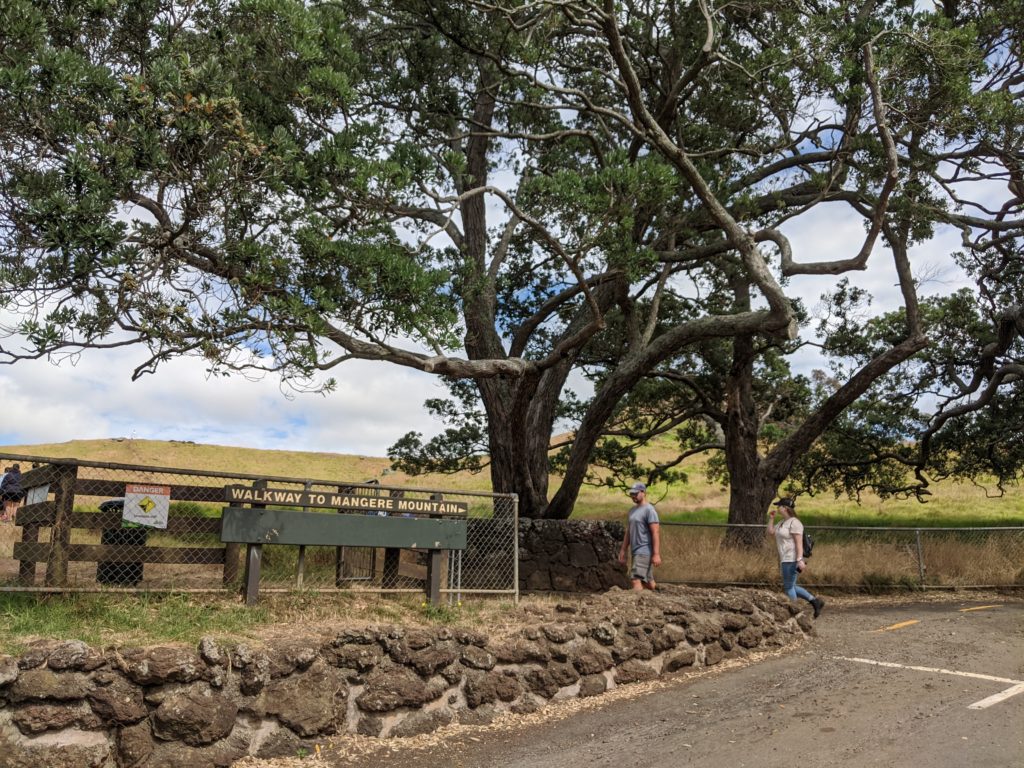
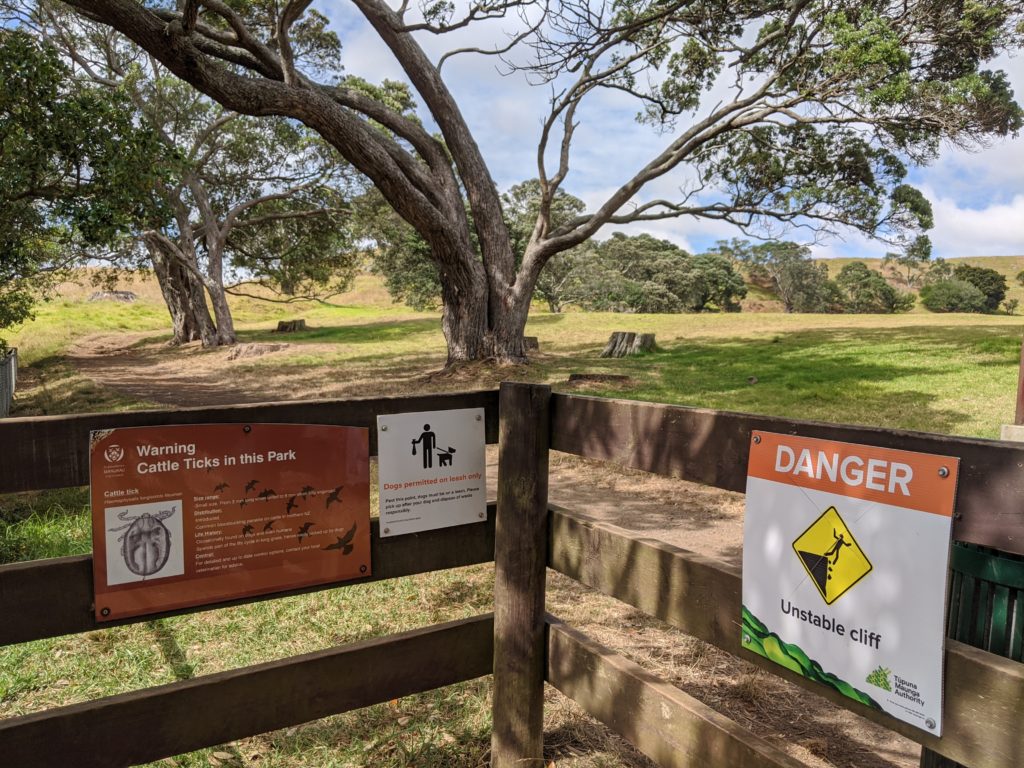
At the beginning of our tour, Mike told us: “we’ll be going backwards in time!” As we drove to our third volcanic peak, Māngere Mountain, he revealed that, yup, this was the 3rd youngest volcano, having erupted about 70,000 years ago.
Unlike Wellington/Maungarei, which was nestled in a residential neighborhood with no parking lot and little signage, Mangere had both a moderately-sized parking lot, more hikers (or tourists?), and a restroom at its entrance. After we went in, we also encountered some interpretative signs explaining what we were looking at.
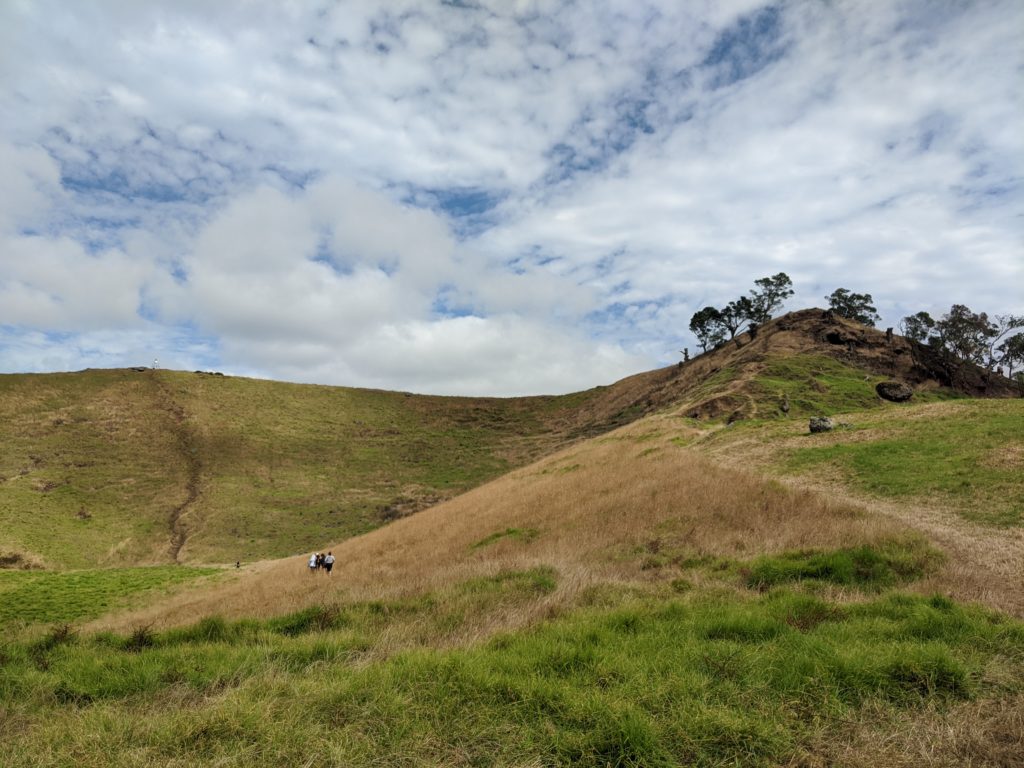
So what were we looking at? Well, it was immediately clear to me that there were three defining features:
- It’s big. (After further research, Mangere turns out to be one of the largest volcanic cones in Auckland, peaking at 348 ft (106 ft)).
- It has not one but TWO craters!
- It still has many hallmarks of being a former major Māori pā.
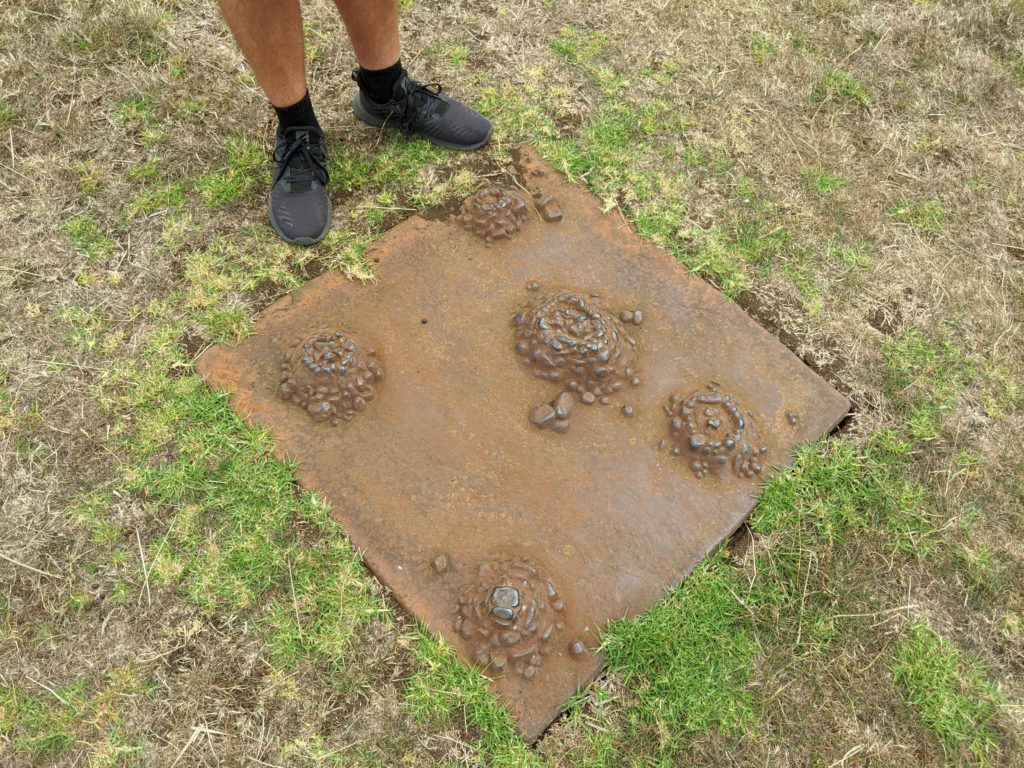
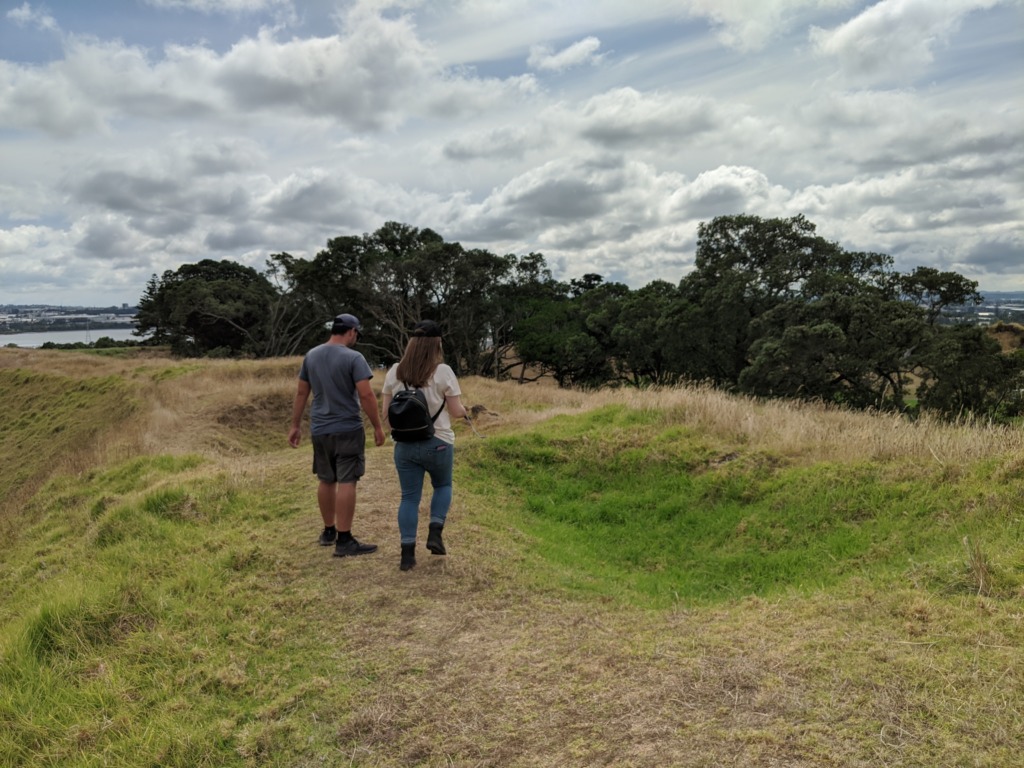
In particular, there was still evidence of rather long, street-like terraces where Māori houses had stood before (not unlike modern-day rows of houses on hills), as well as pits where kumara, taro, and potato (which was introduced later, I think, by the British?) were stored. As Mike had previously explained at Wellington, these pits kept food dry and temperatures stable.
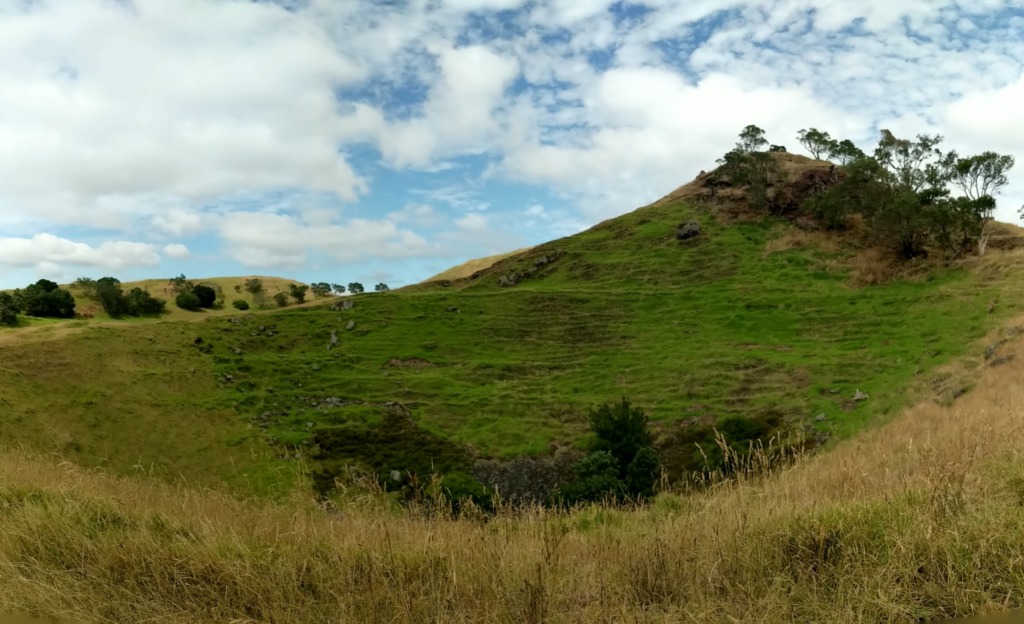
I kind of wanted to go into the crater, similar to what we had done at Wellington. But we took the carved out trail around the park, and I saw no one else enter. (And, an adjunct to Leave No Trace principles is really to stay on the beaten path; otherwise you’d be contributing to erosion.)
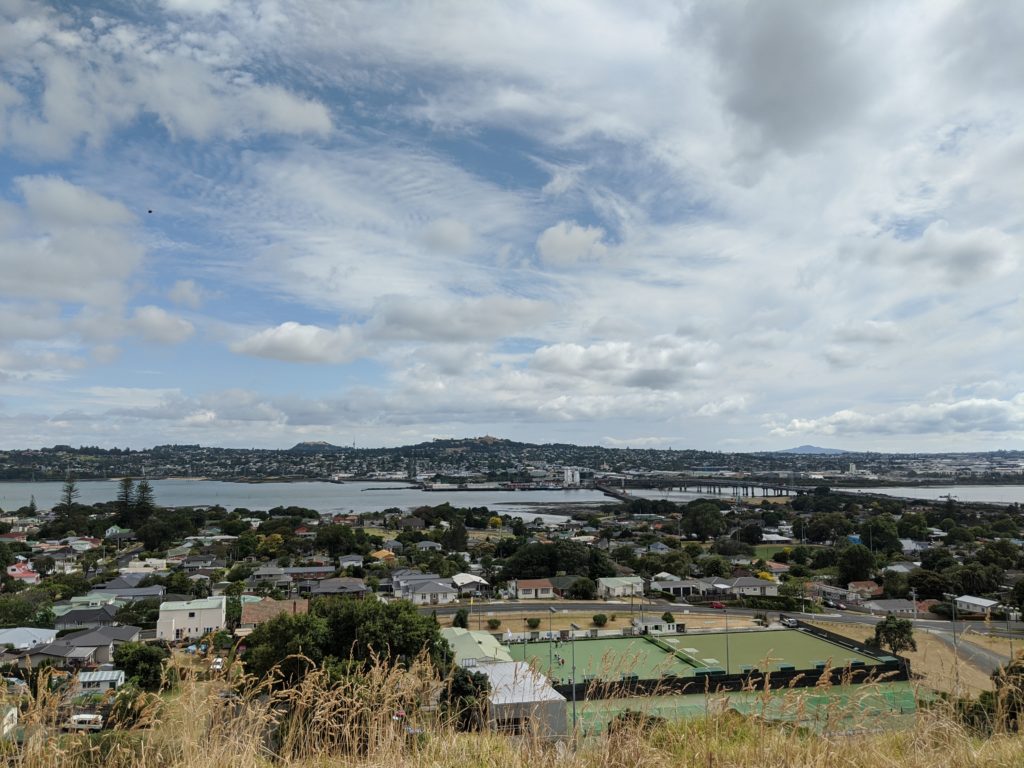
Like Wellington earlier, Mangere Mountain was also surrounded by development, especially toward its north and northeast.
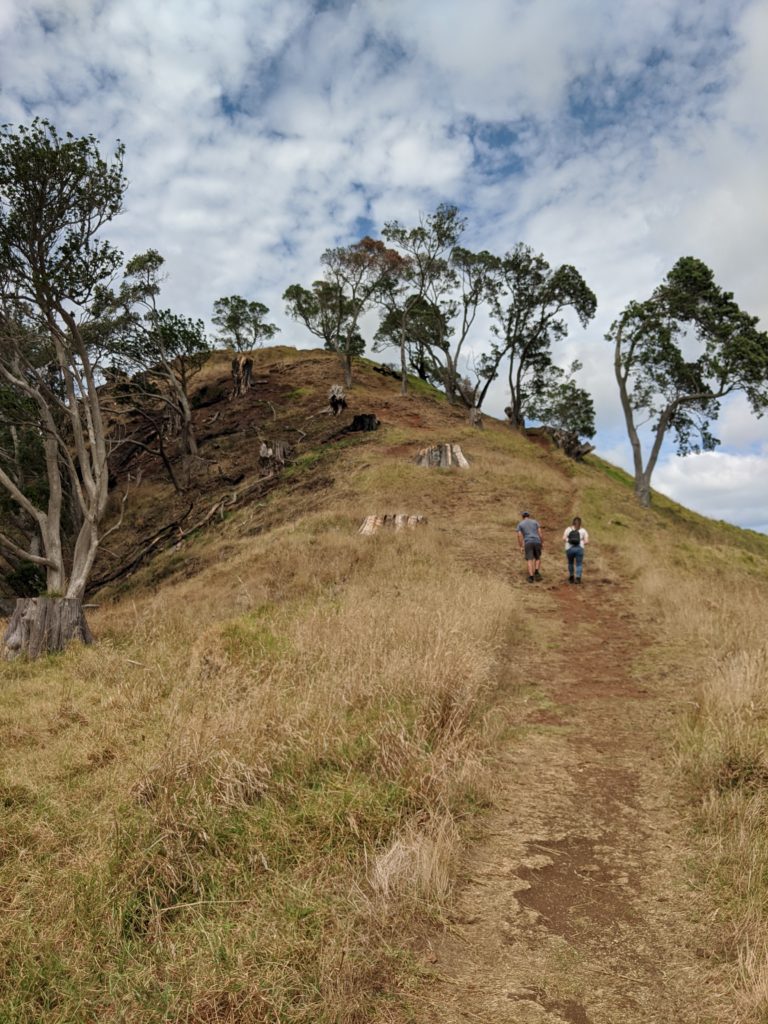
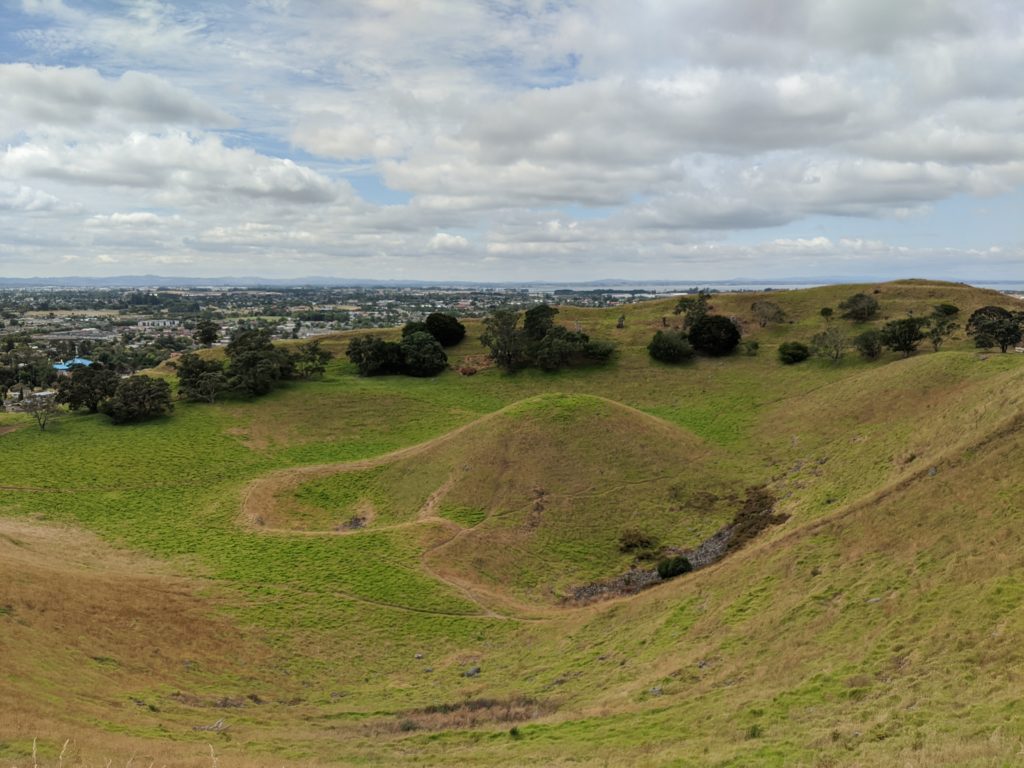
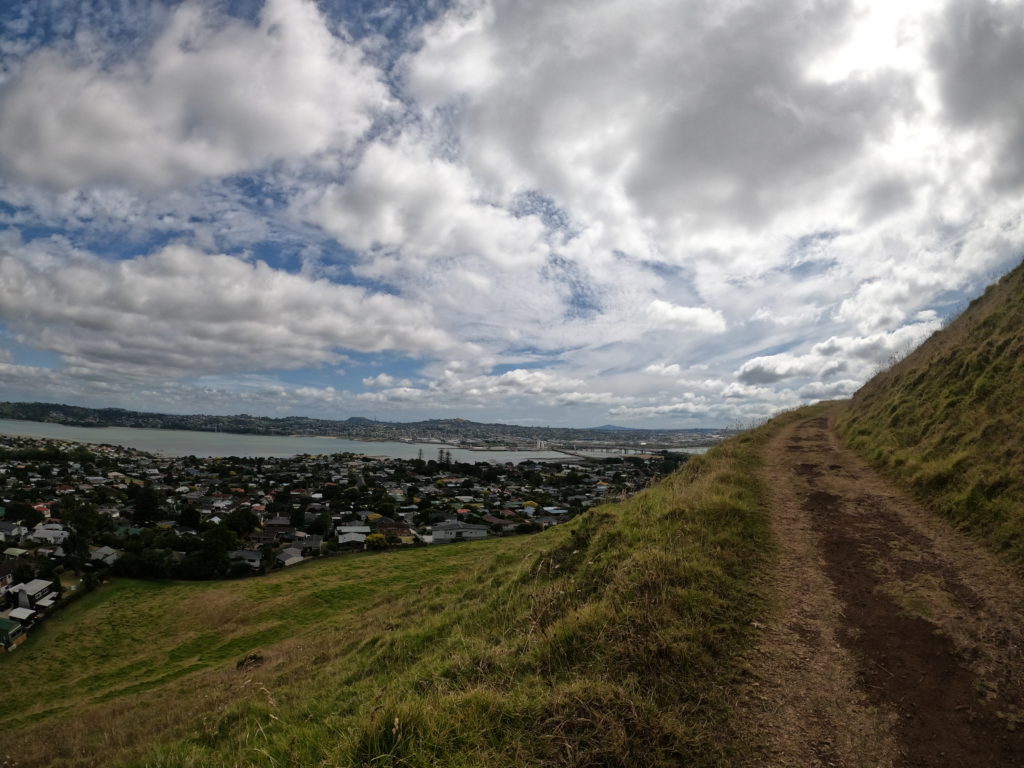
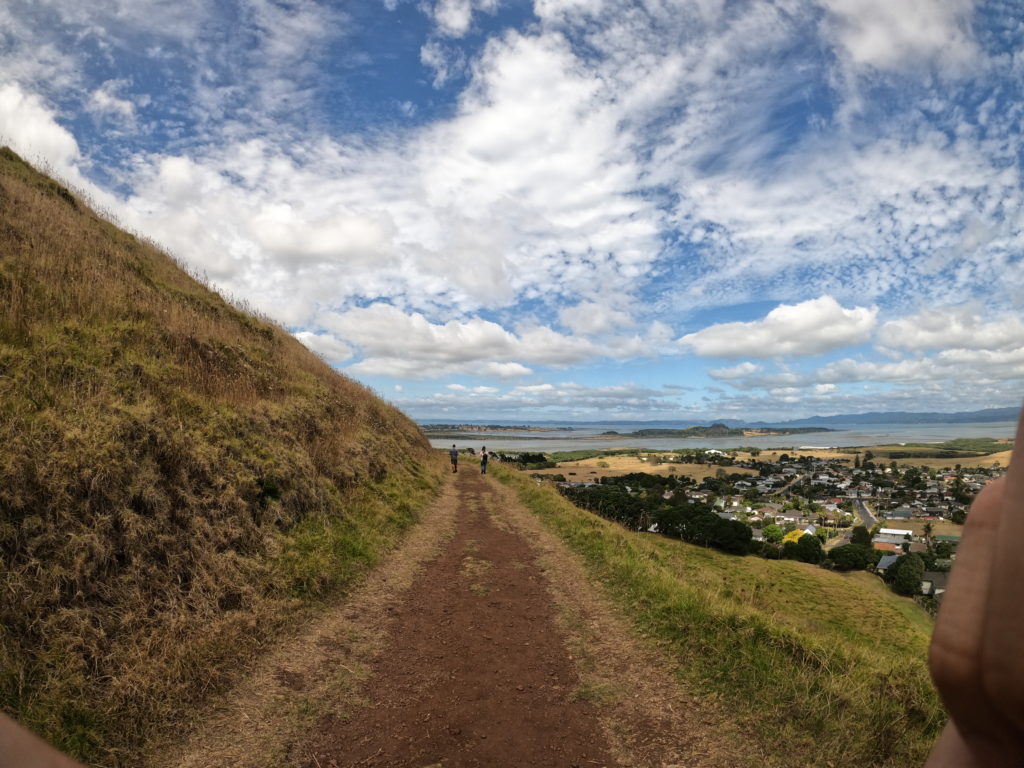
Now that I’m looking back at photos that I took, I realize that I didn’t take photos of more indigenous artifacts of life here, like wedges that demarcated where family land boundaries were, or possible locations of moats, trenches, and fences.
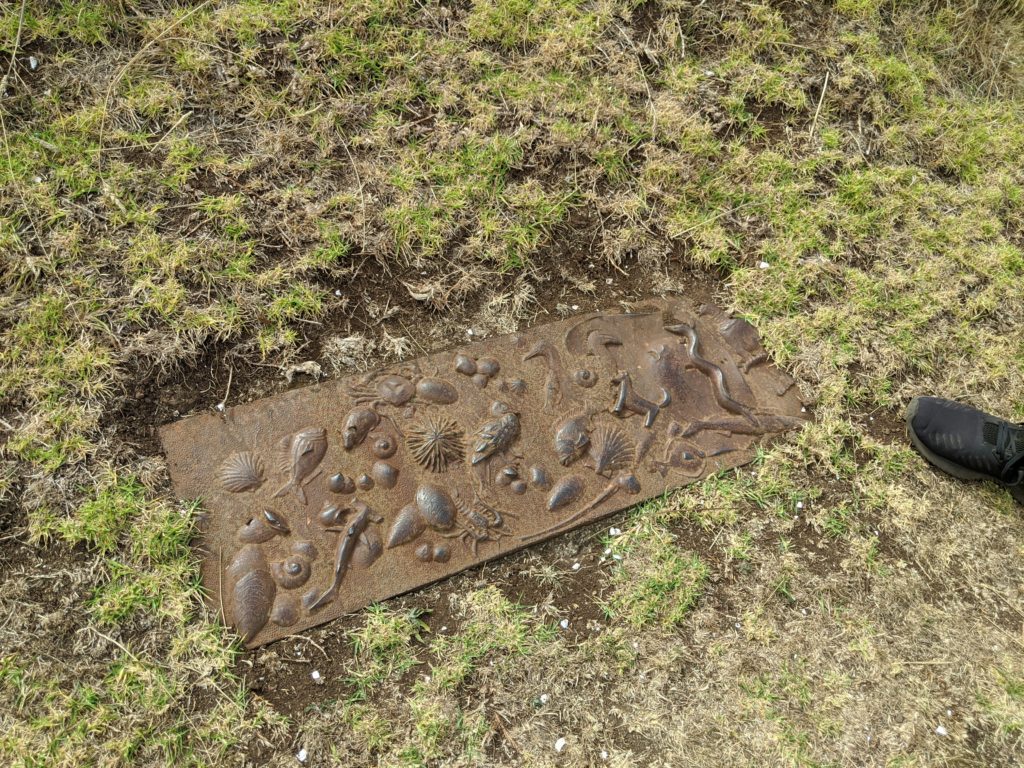
Definitely got to enjoy the scenic beauty though!
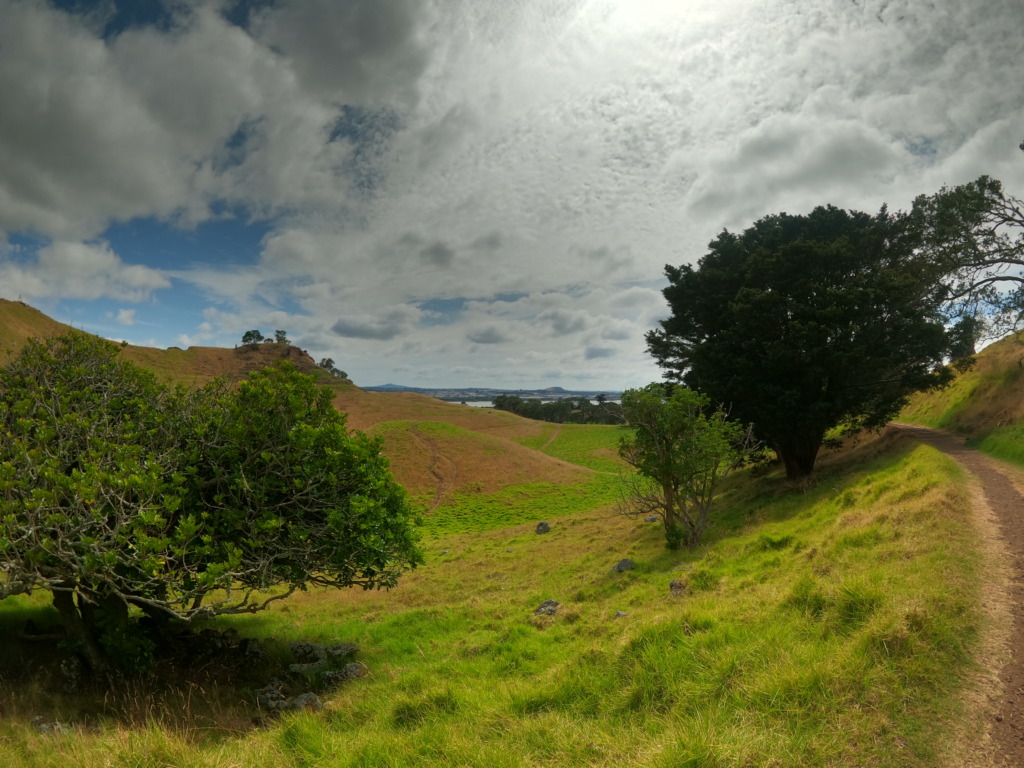
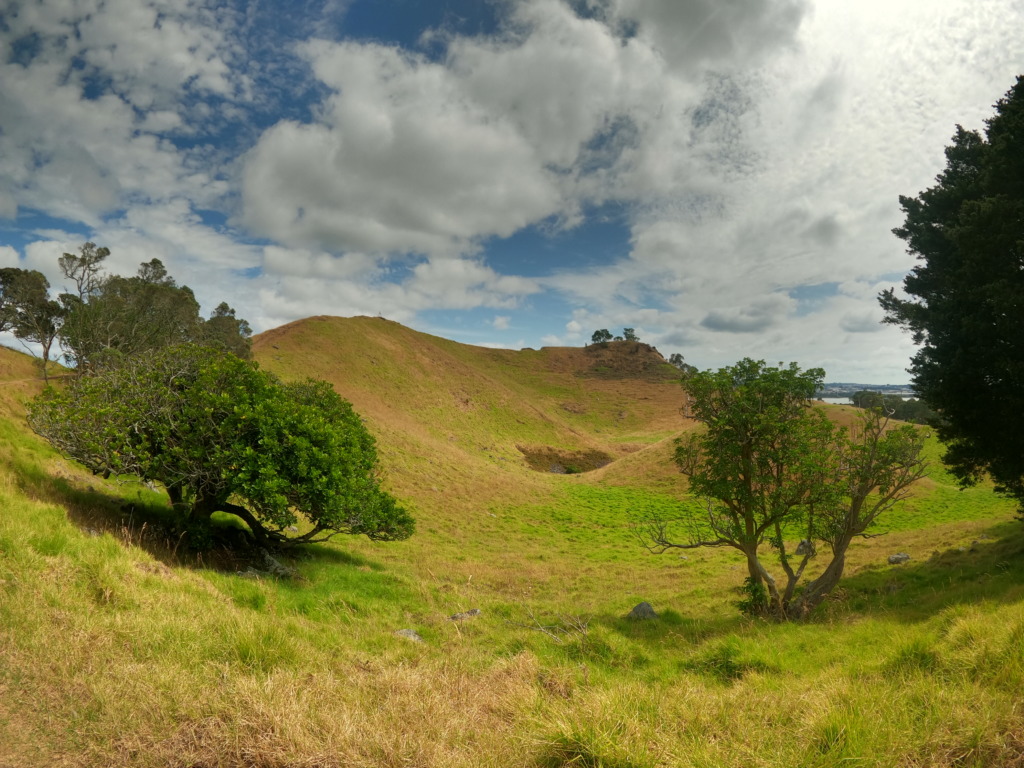
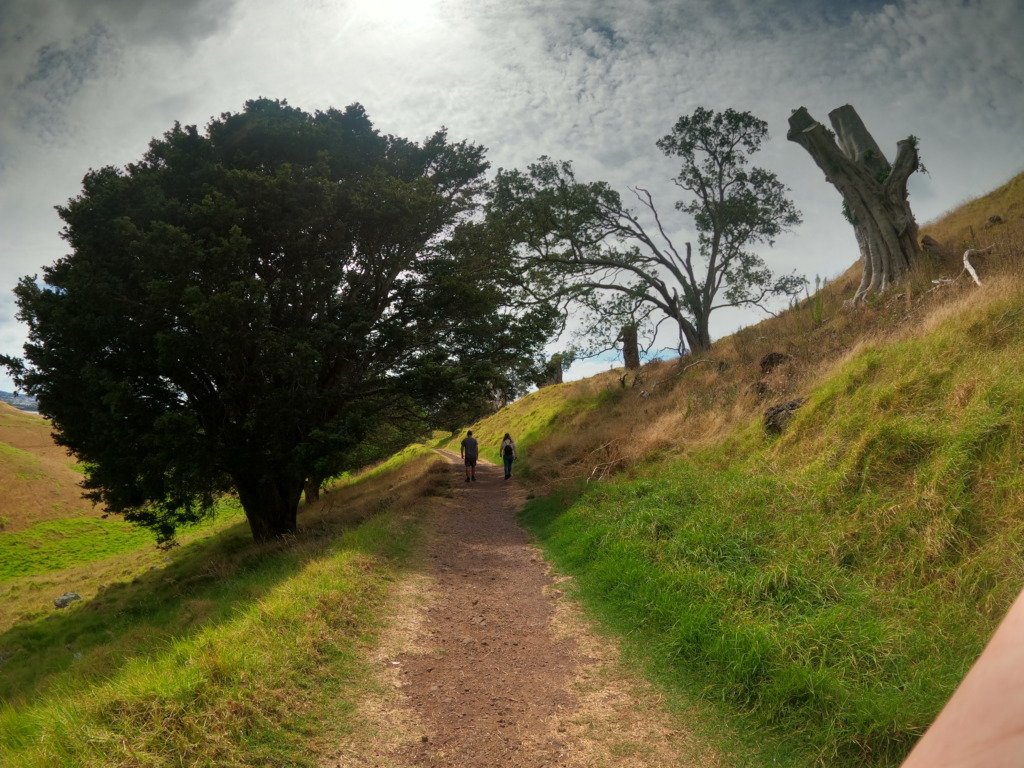
New Zealand Pastries
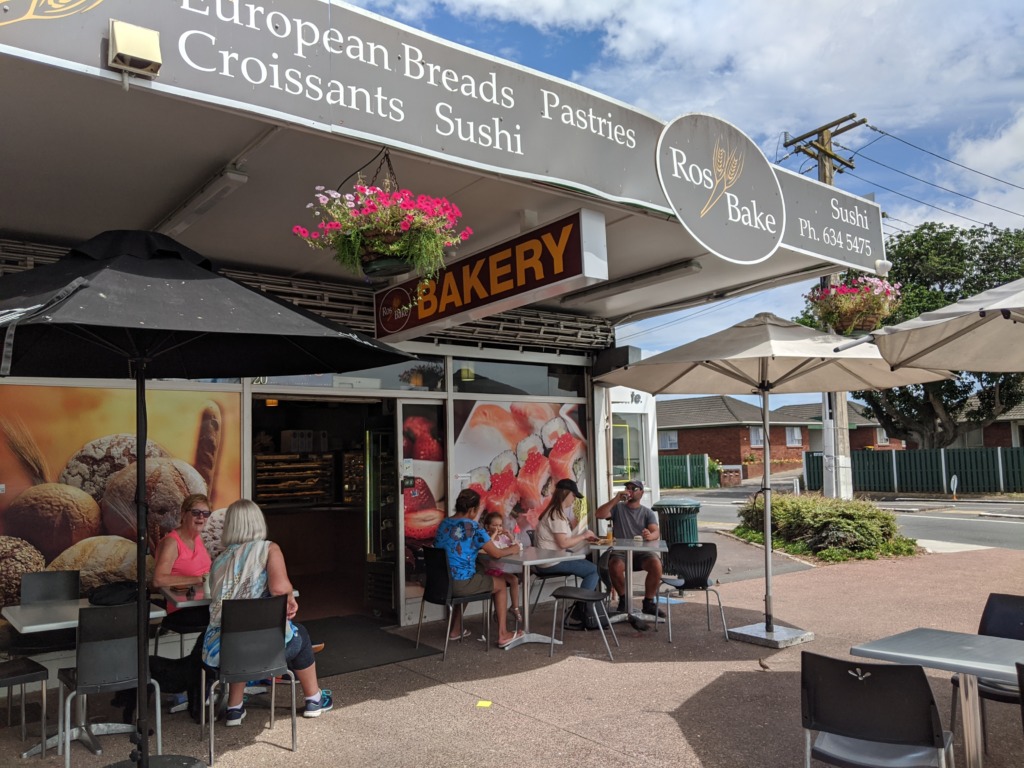
After we left Mangere, Mike asked us if we were hungry.
Neither me nor the Australian girl was. But I was curious where he would take us to, if we were. I was also curious what “New Zealand cuisine” was, anyhow.
In the end, Mike decided that I had to try some New Zealand pastries, as we passed by this Ros Bake bakery (I saw more Ros Bake’s later on, so I realize now that this is a chain).
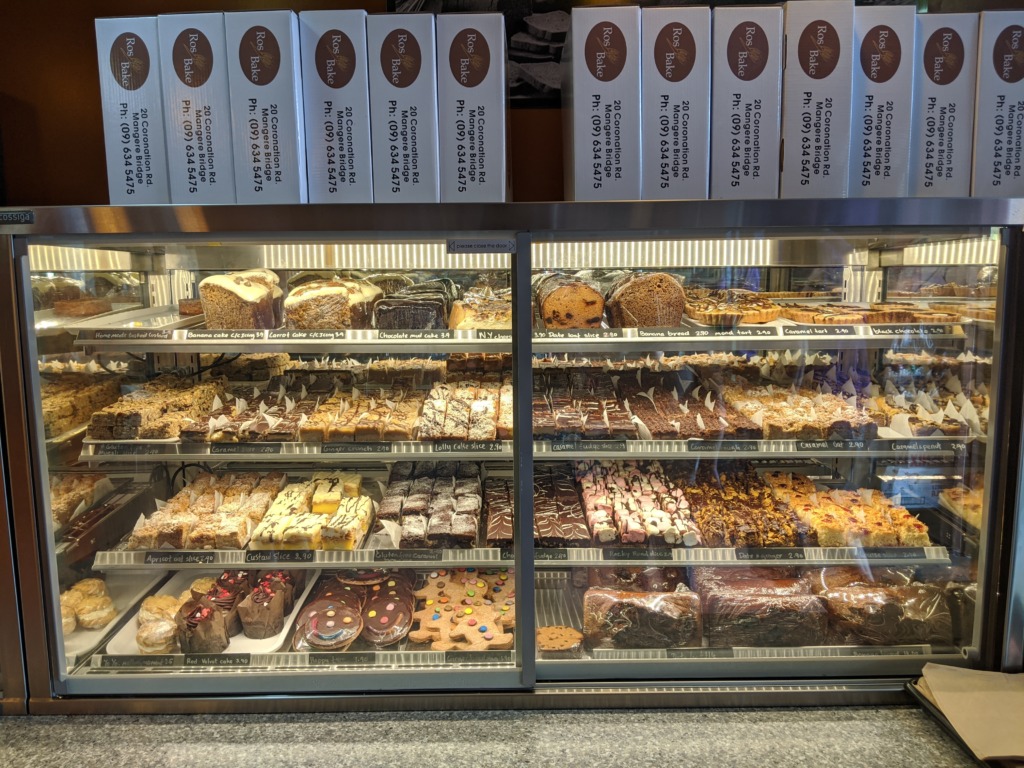
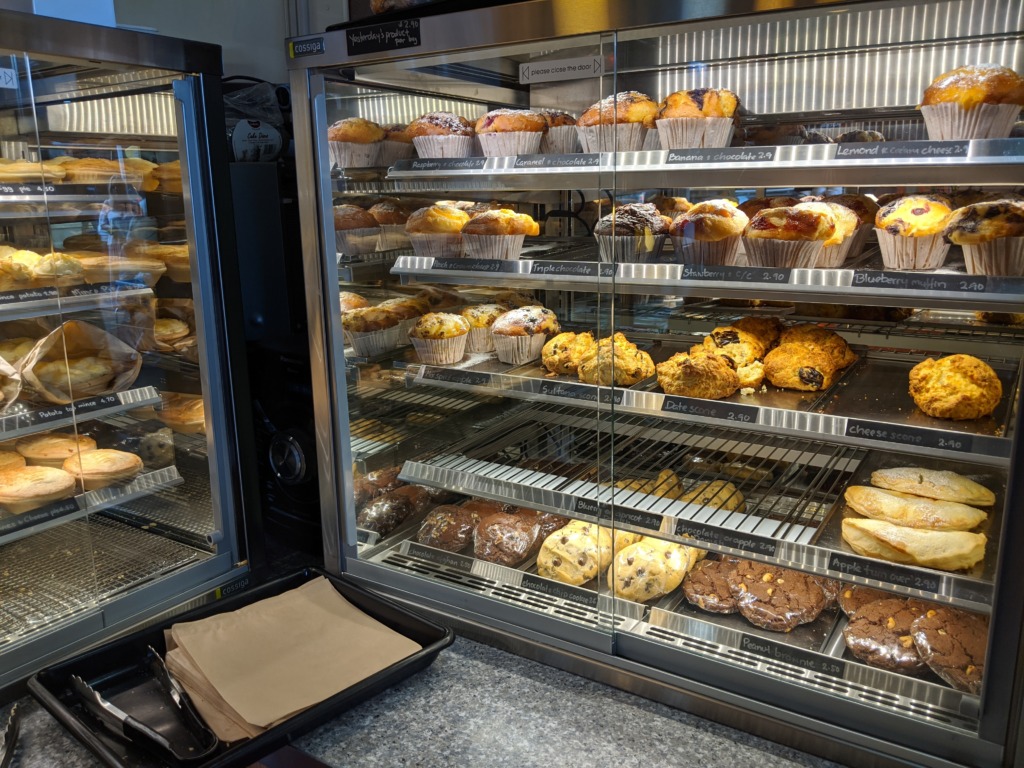
What I was most surprised by was that there were actually not much bread, croissants, and muffins: things that might dominate a typical Northern Californian bakery. Rather, there were pastries — LOTS of pastries. Very sweet-looking pastries.
Anyway, in addition to the “Afghan” that Mike said that I had to try, I picked two pastries with funky-sounding names.
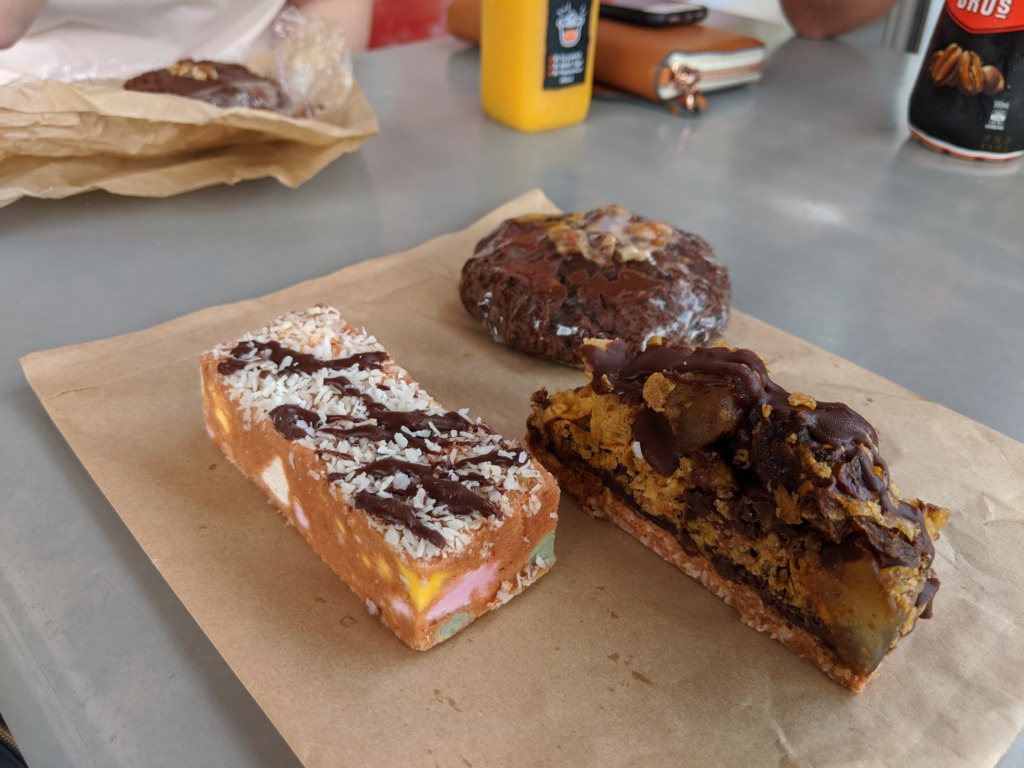
This was a mistake. I mean, I enjoyed the experience of trying something new, but I could help but immediately exclaim: “This is candy!”
For better or for worse, I ate about half of each bar. Then I decided that I had had enough. I was sure that even one of these bars had enough sugar and calories to last me for the rest of the day. Even as I write this now, I’m recoiling at just how cloyingly sweet these two bars were (I saved the afghan for later).
Volcano 4: One Tree Hill / Maungakiekie
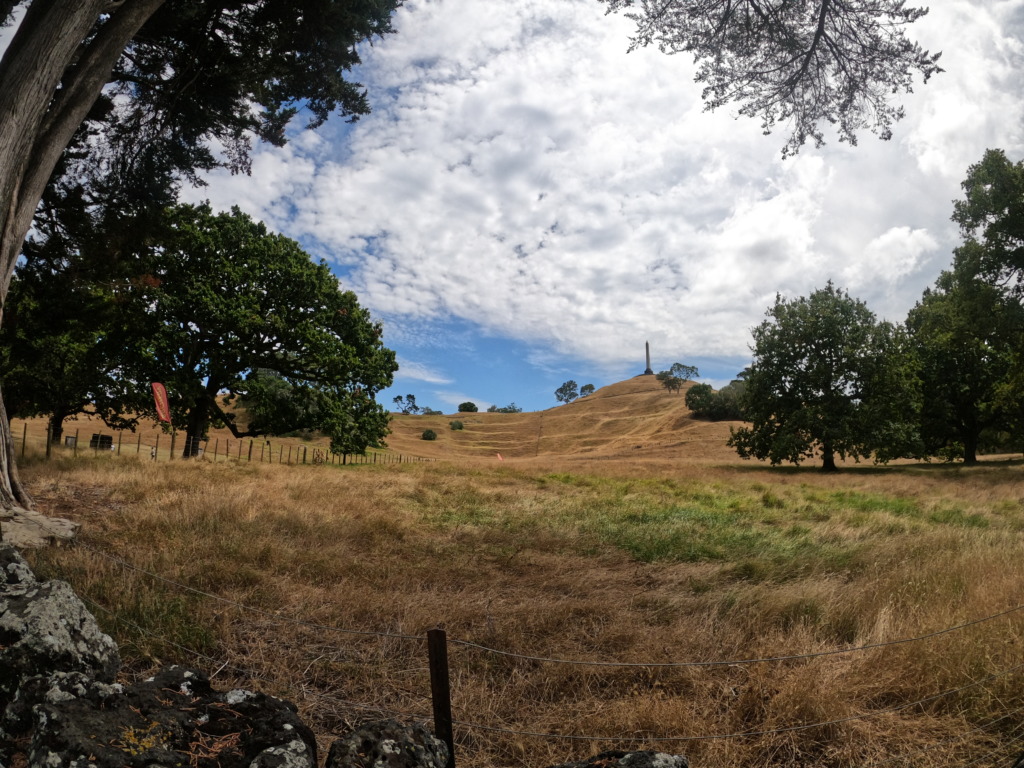
As we pulled into the parking lot for One Tree Hill, also known as Maungakiekie, our 4th stop, Mike told us: “it’s time for a history lesson.”
“How much do you guys know about New Zealand’s history?”
I racked my brain. I knew New Zealand was once a British colony. I also knew about Waitangi Day, a national holiday celebrating the signing of the Treaty of Waitangi — because it was happening 2 days after this tour, and 2 days before my ultramarathon.
Embarrassed, I told Mike that I didn’t know much. Surprisingly (to me), this was also the case with the Australian girl; apparently she hadn’t learned that much specifically about New Zealand in school (though obviously a lot more than I had).
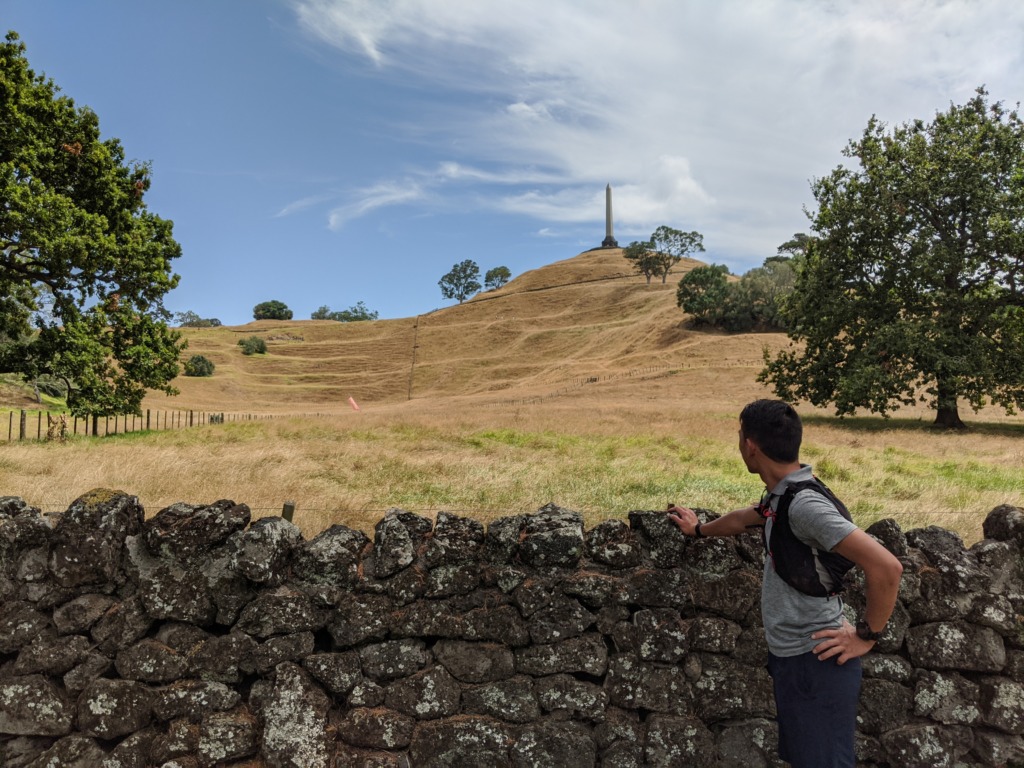
After a quick crash course, Mike eventually asked: “Why do you think this place is called ‘One Tree Hill’? There’s clearly not a tree on top of the hill?”
I knew the answer to this one: there must’ve been one tree there before!
“Well, yes, but why isn’t it there now?”
“Someone cut it down!”
“But, why???“
As it turns out, according to Mike, the tree on top of the hill was not native. So some Māori natives saw it as a symbol of colonialism. Ultimately, activists attacked it with a chainsaw (twice actually), to draw attention to injustices by the New Zealand government (possibly tied to the alternate translations/interpretations of the Waitangi Treaty between the British Crown and the Māori tribes — I’m told that the Treaty was translated into both English and the Māori language, but there were differences in their translation). These attacks were actually quite recent, with the second, fatal attack in 2000. (To the New Zealand government’s credit, recognition of the Māori, as well as reparations, continue, more or less fairly, today.)
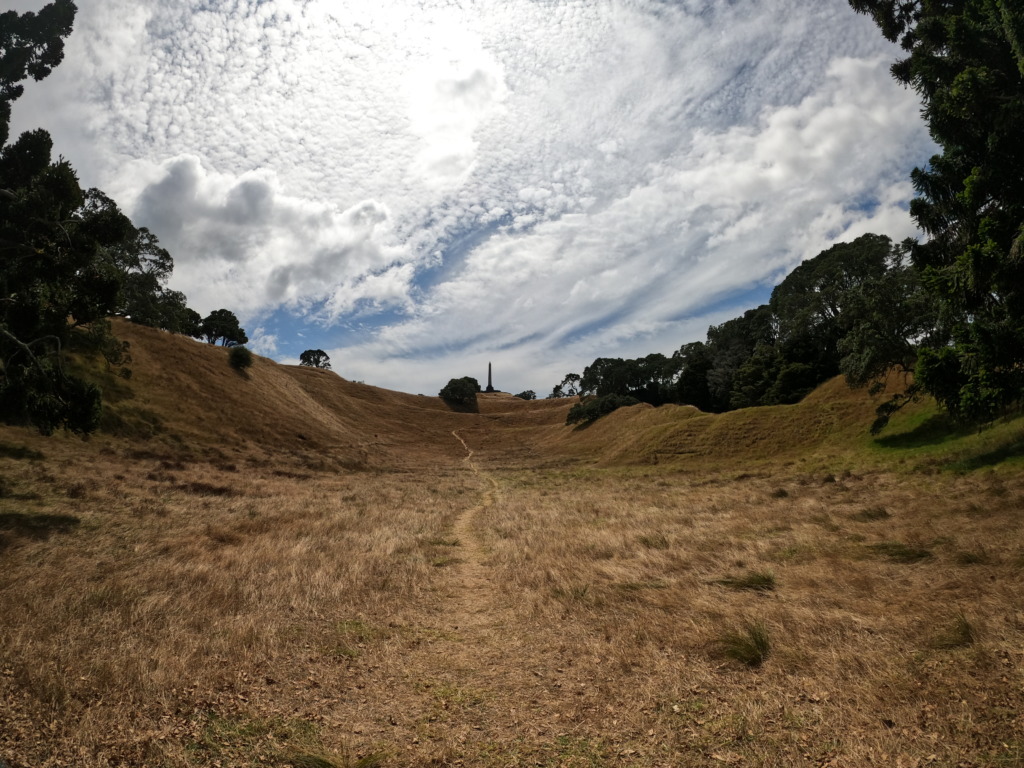
Though Mike briefly talked about the obelisk and the “commemorative” warrior statue (erected by European settlers who thought that the Māori would die out, and therefore should be commemorated), we didn’t have time to actually hike up the hill.
Rather, we’d save more time for Mount Eden.
Volcano 5: Mount Eden
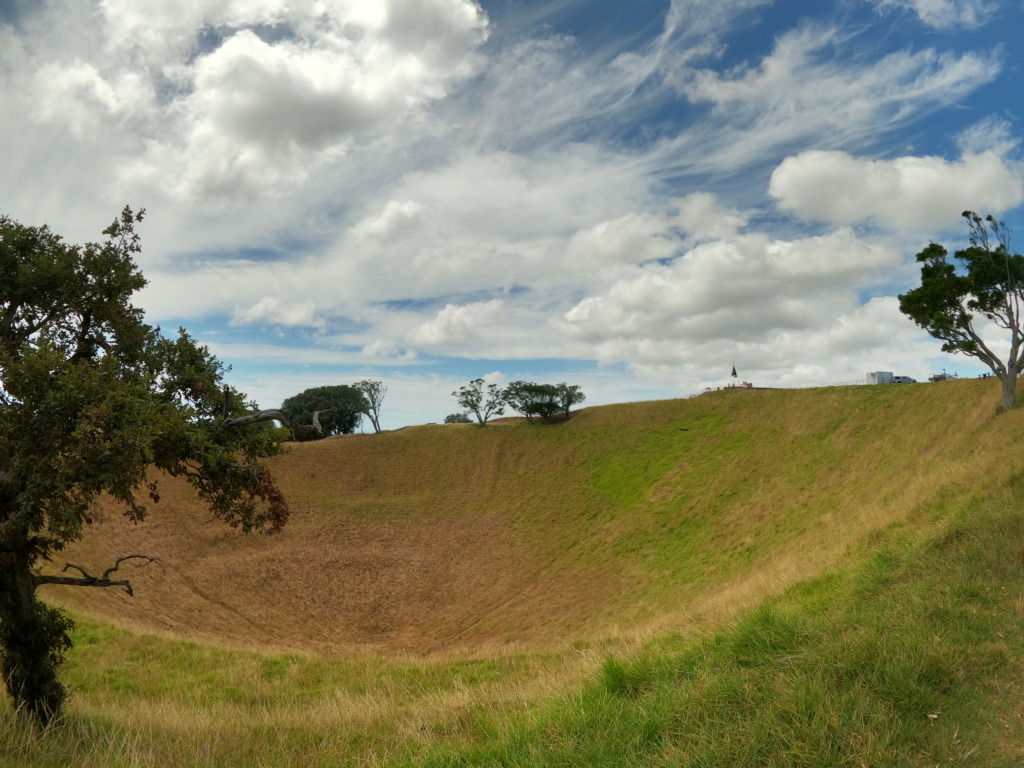
When I started the tour, I confided to Mike that I was worried that I’d get tired of looking at holes in the ground. Before booking this tour, I had read some reviews. All of them were positive, but most of them had booked the half-day tour. One full-day tour that stood out to me mentioned that, after looking at volcano after volcano, everything started to look the same.
Personally, I’m always a little concerned about this, broadly, when I travel. Especially without context or knowledge of “why this is different”, even special destinations start falling into the same bucket. Historic building! Beach! Mountain! Tree! Or, in this case, hole… big hole!
Luckily, Mike had some homework, so he was able to answer most of my questions; there hadn’t been too many interpretative signs (I love those things) explaining the places that we had been to so far, so I was glad I had a guide.
Even more luckily, as we arrived at Mount Eden, I noticed that there was actually a “Visitor Experience Center!” Which might have more information I was craving.
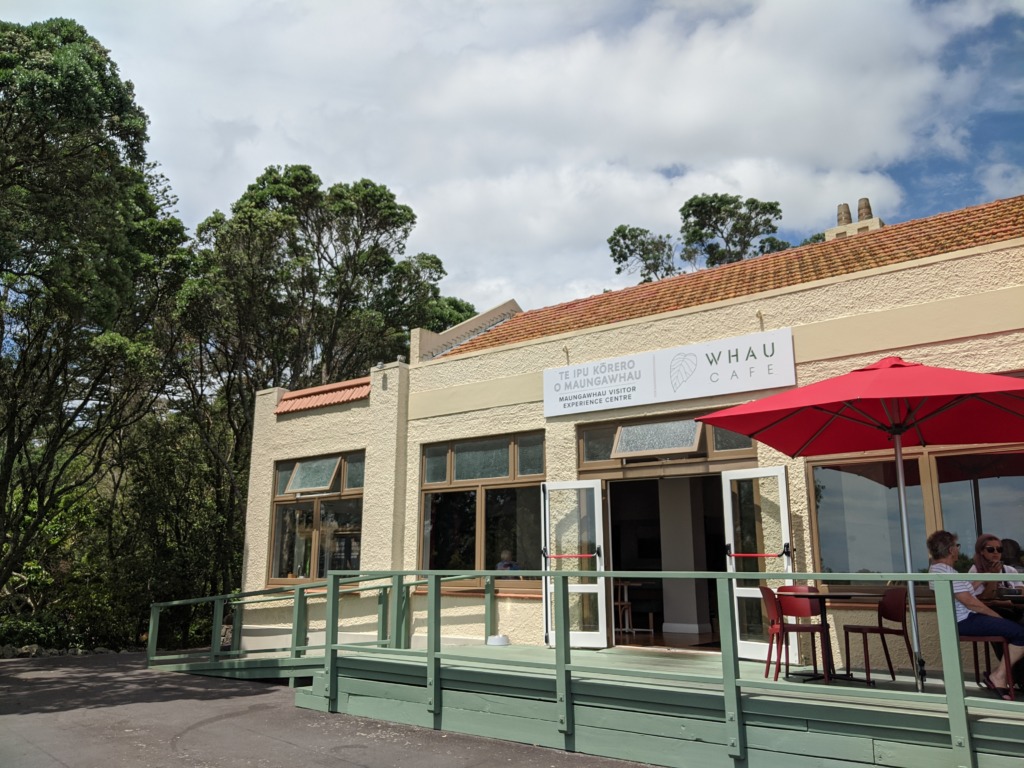
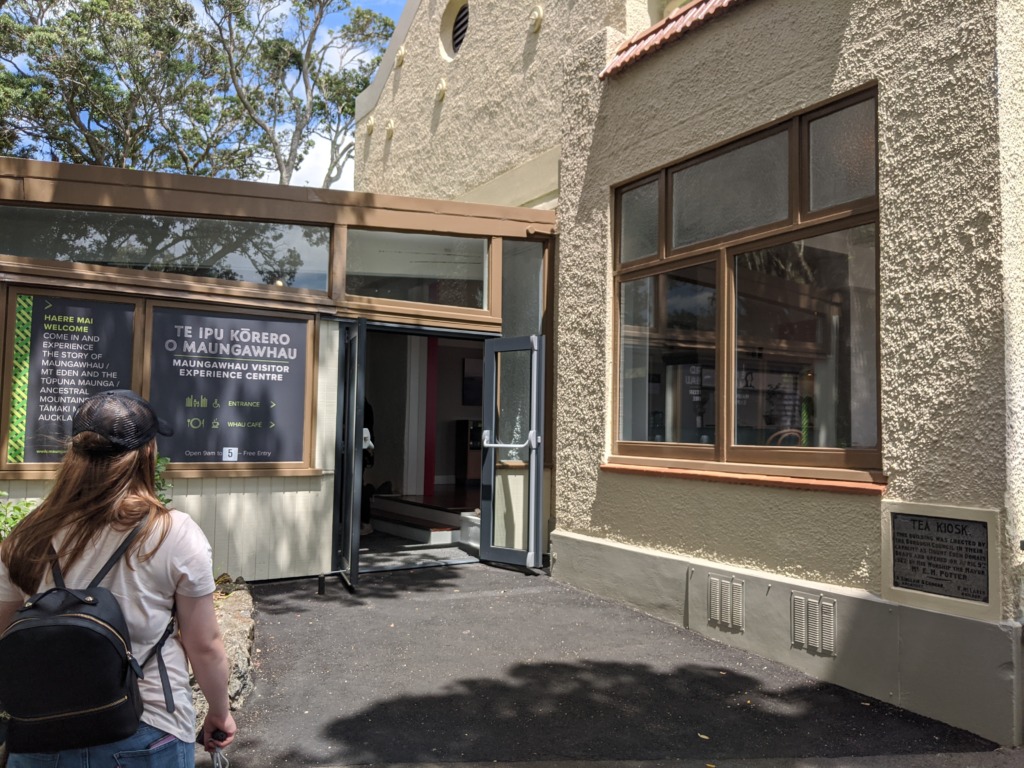
Finding this visitor’s center was, in fact, an accident. As we drove on the road going up Mount Eden, Mike noted that there were more cars than usual. In fact, someone had taken his usual parking spot! So he had to continue up the road looking for parking, which we eventually found near the Whau Cafe, near the end of the road (that was accessible to normal cars).
Mike hadn’t realized that this visitor’s center existed. This was actually his first time seeing it, despite bringing guests up the mountain almost daily. I insisted that we check it out. Though he was a little reluctant (since we were a little off-schedule), Mike was pleasantly surprised once inside: “They should’ve built this a long time ago!”
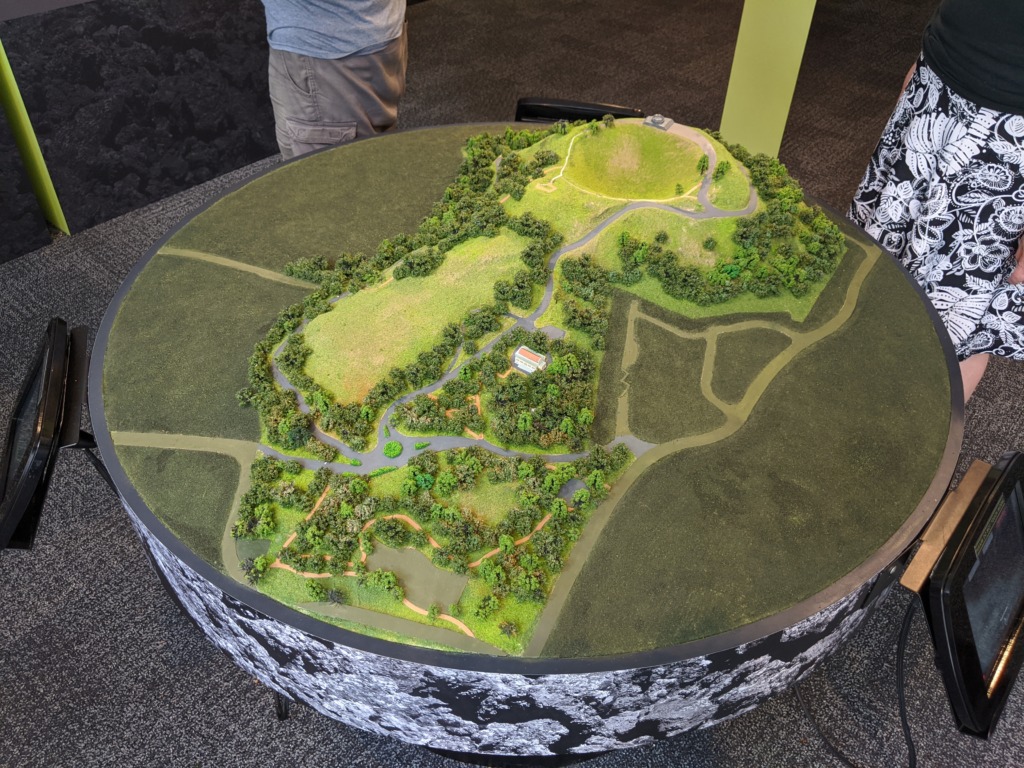
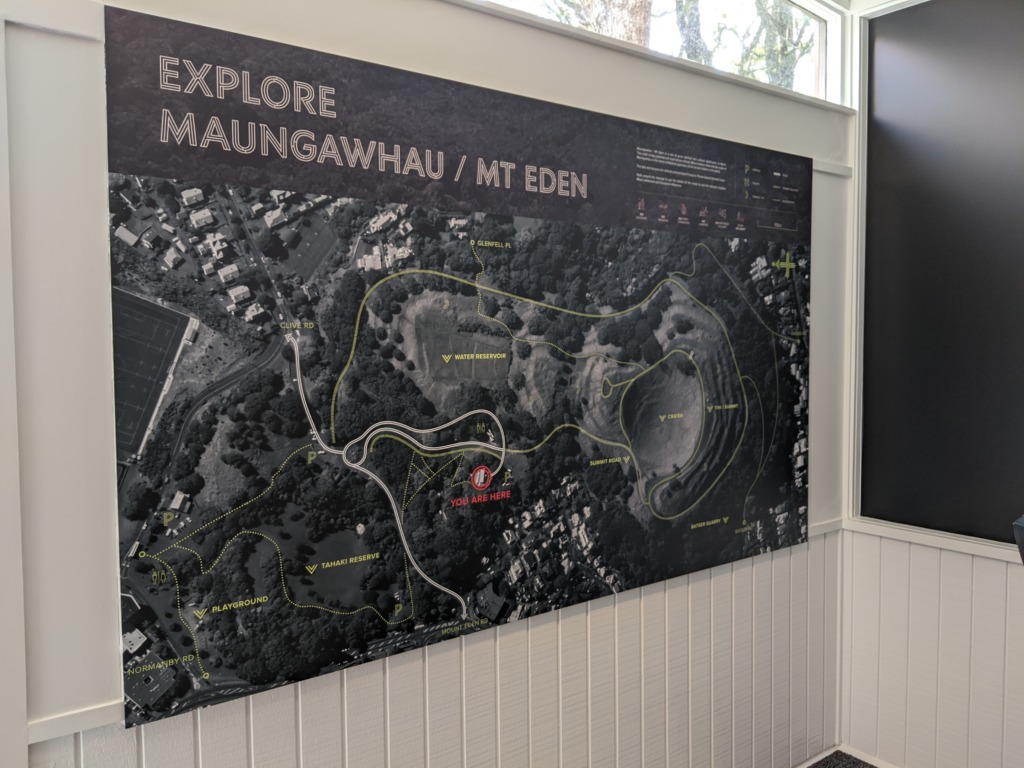
Inside, the first thing I noticed was the miniature of the mountain. I hadn’t been up to the top yet, but it already gave me some sense of how beautiful it would be there.
Then I noticed the maps and photos lining the walls. They explained the origins and characteristics of Mount Eden the volcano, the historic significance of Mount Eden, the Māori pā, and the relationship of Mount Eden as part of the “ancestral mountains of Auckland.” There was also ample description of the process of returning Māori ancestral lands back to Māori ownership, as well as a small theater in the back playing a 15-minute video for anyone too lazy to read the posters. 🙂
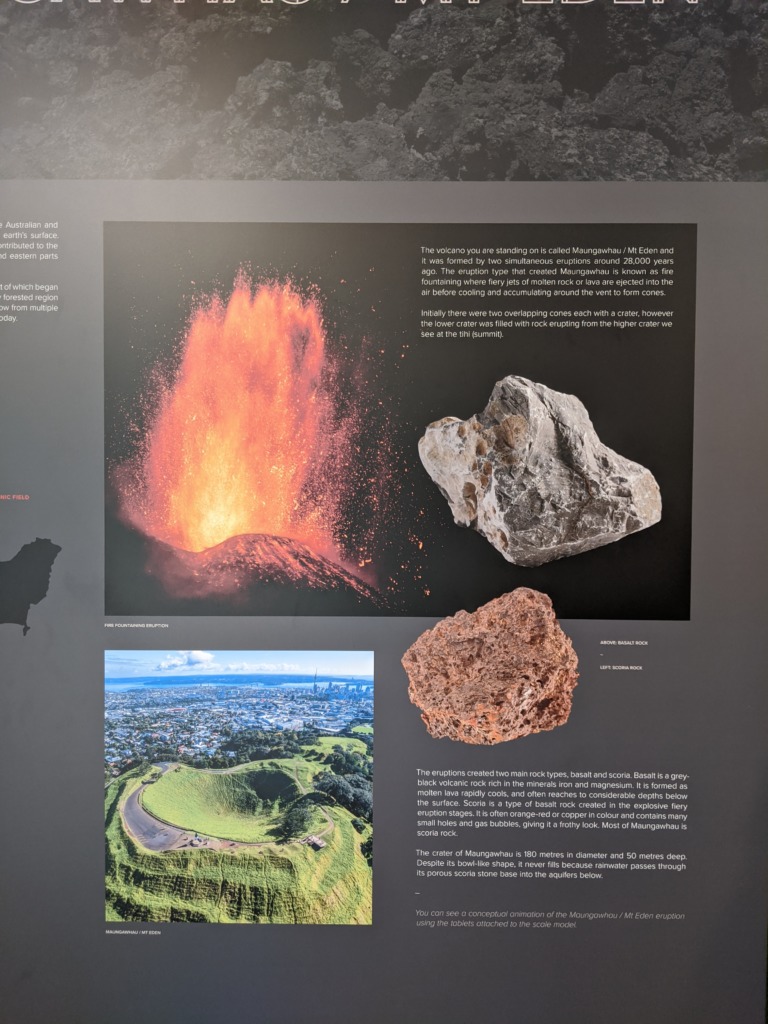
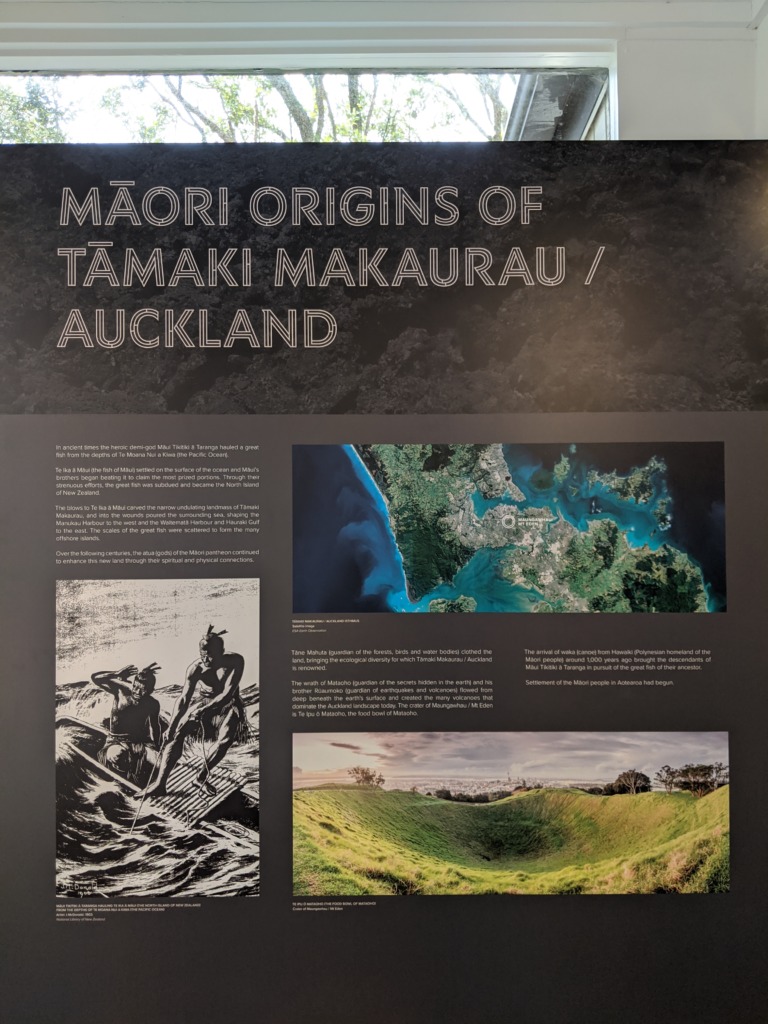
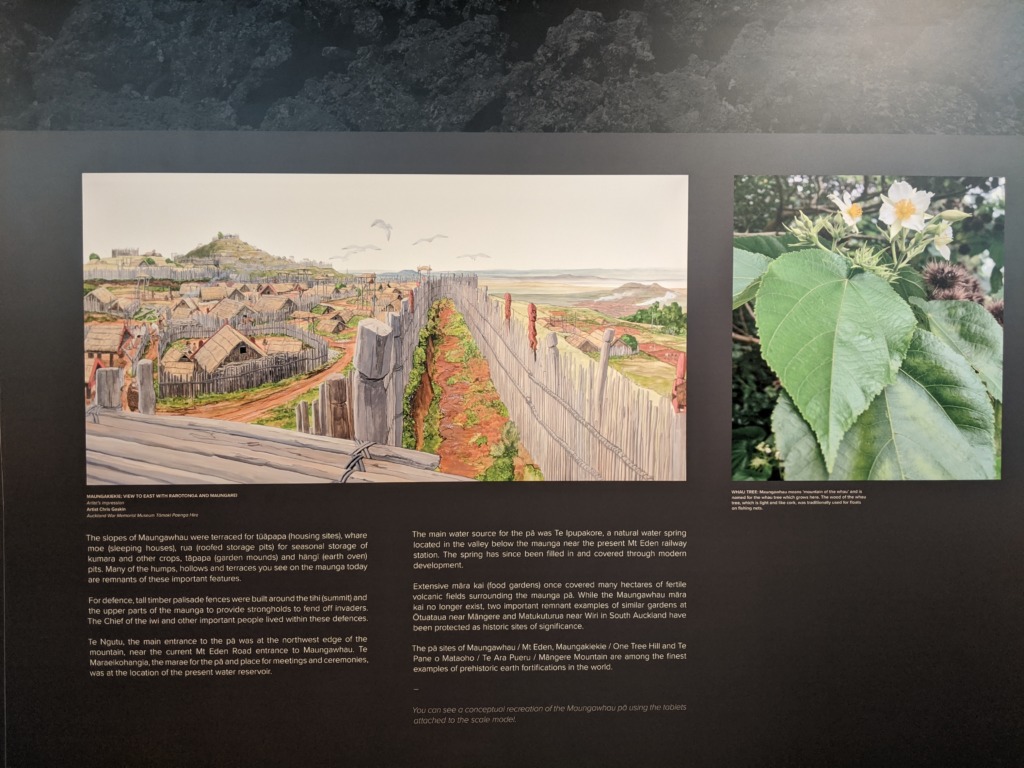
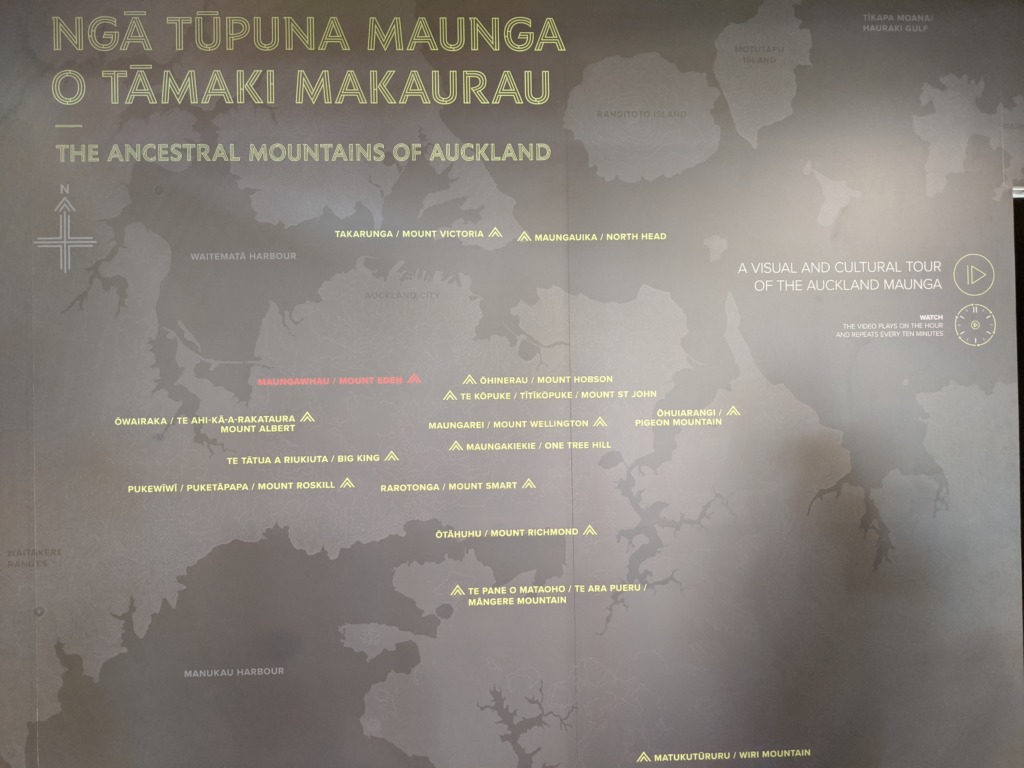
None of us were particularly hungry, so we didn’t stop inside the cafe. When I peeked inside, though, I was surprised by how nice it was!
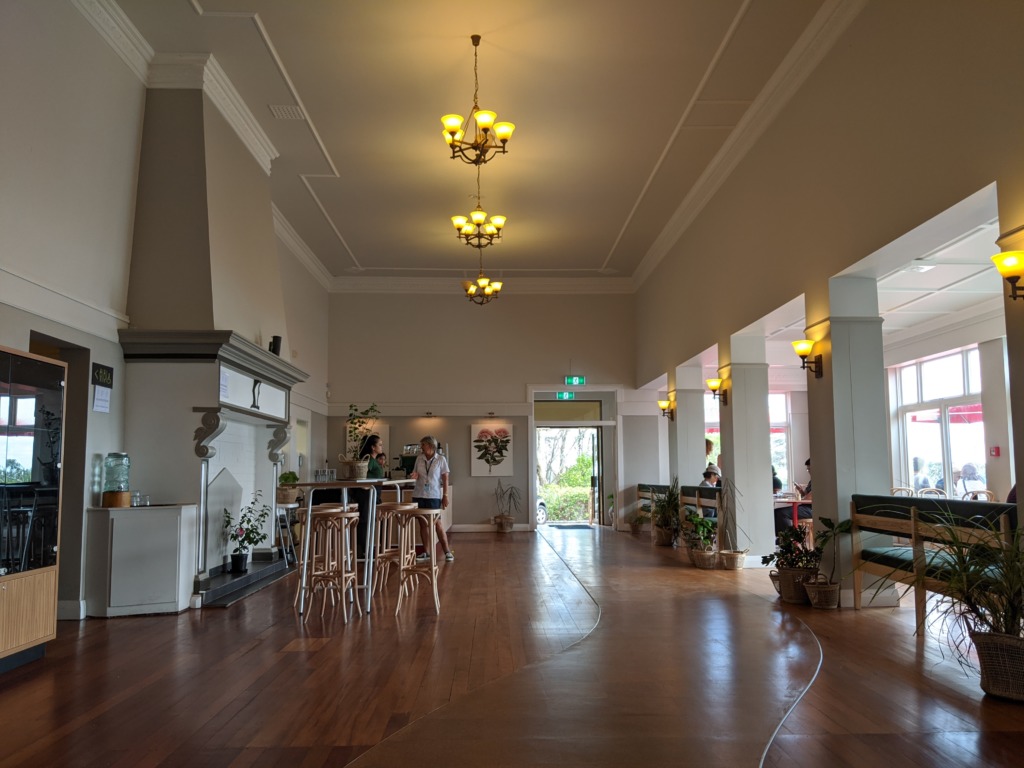
As we left, Mike thought out loud: “I’m going to start bringing people here.” At the time, I thought it was strange that a local tour guide wouldn’t know about this mini-museum halfway up the mountain. But upon further research, it turns out that this cafe and exhibit are quite new! I’m glad I got to see it.
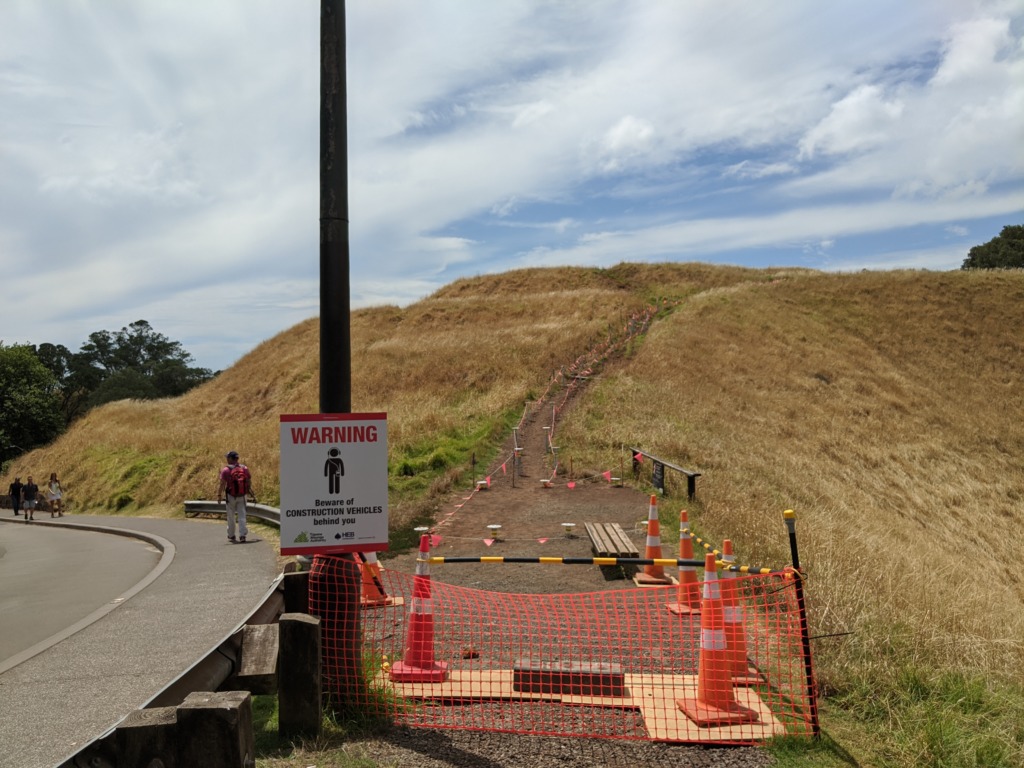
Further up the trail, it was apparent that there was some construction or maintenance going on, though there were actually any workers there (as far as I could tell). But there were fenced off areas and bright orange-red webbing with signs telling people to stay away. (Unfortunately, this meant that we would only be able to go up and down one-way, rather than around the crater/park).
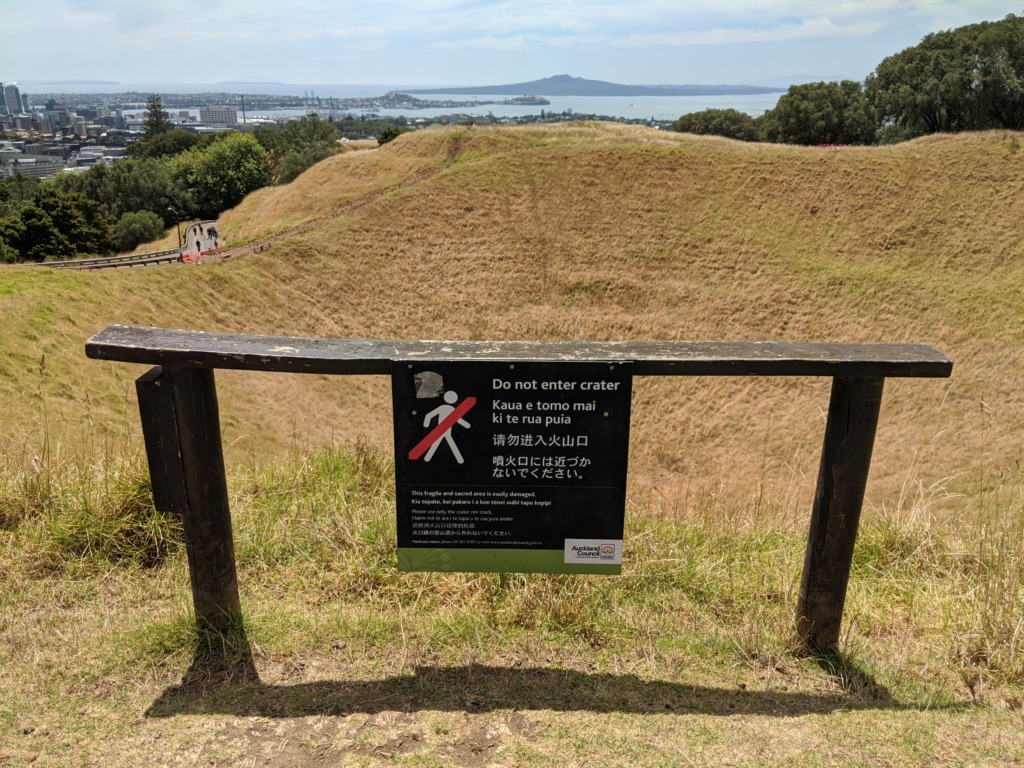
That said, Mike also told the Australian and me, the American, not to venture off-trail, and especially not to set foot into the crater itself. “This crater is sacred,” he explained. “The Māori call it the ‘bowl of the gods.'” (Through later reading, it’s apparently the bowl of one god, “Mataaho”, giving the 160-foot-deep crater the name “Te Ipu-a-Mataaho”.)
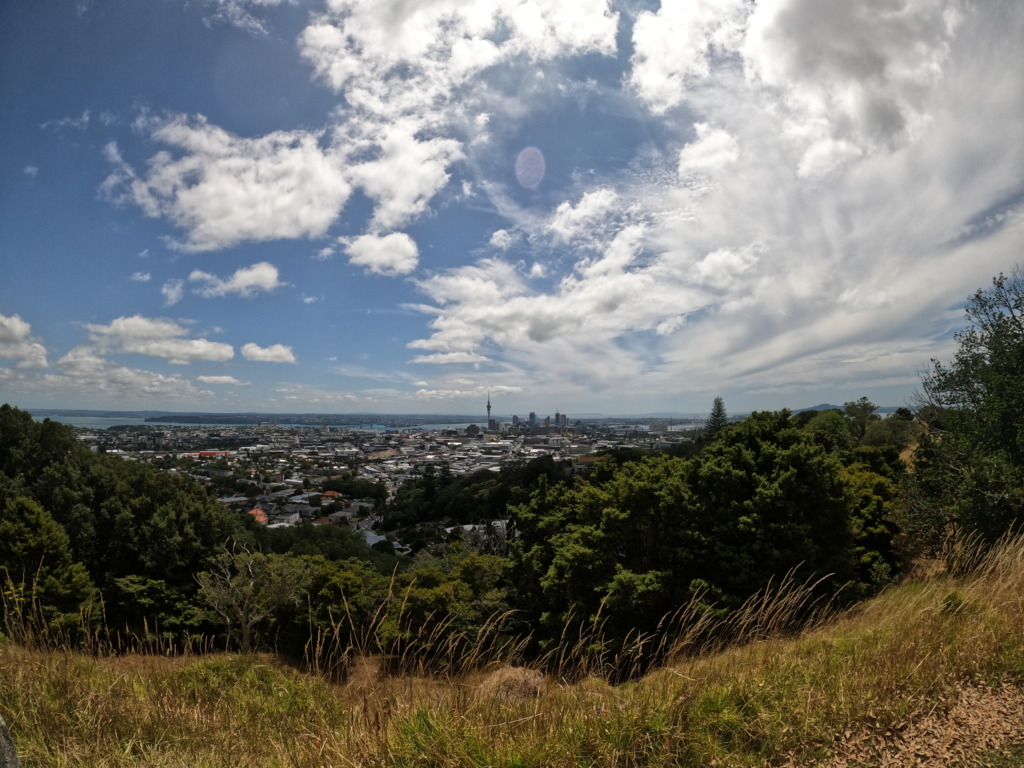
At the actual summit, there was a tall, wooden pyramid-shaped structure, and a smaller round stone structure. The black-and-white striped pyramid, I was told, was for navigational and geologic surveying purposes. The smaller round table-like structure had plaque on its side, and directional map on top, pointing to where other points of interest lay.
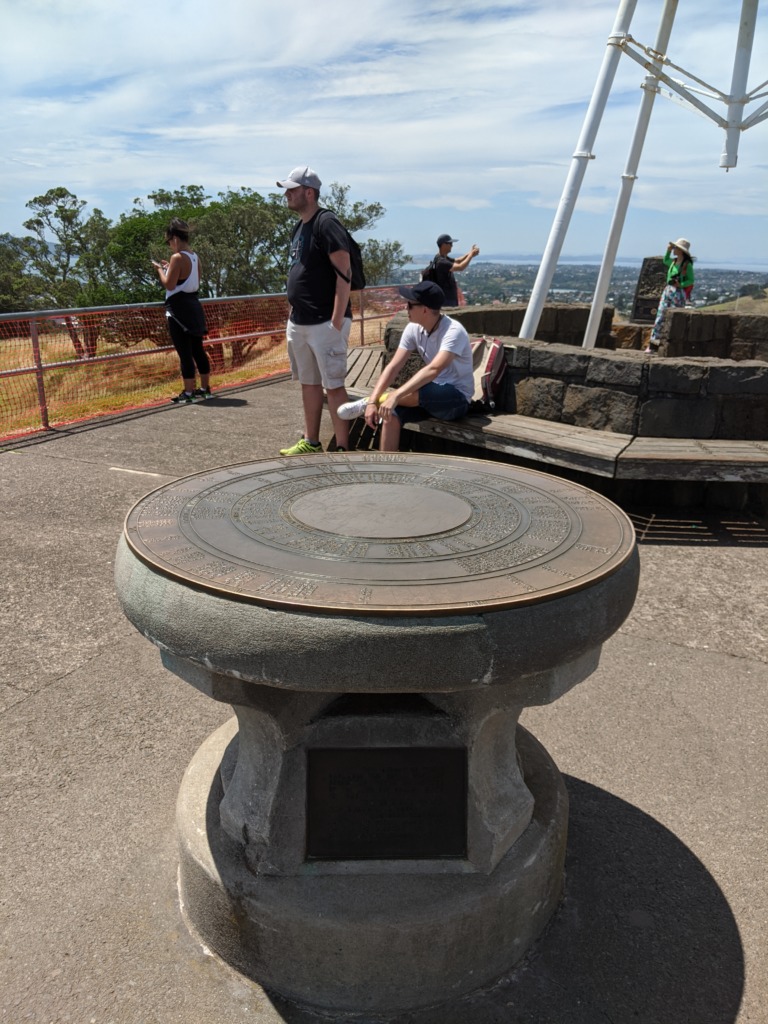
Interestingly, throughout my two days in New Zealand (this was my second day), I had encountered many Chinese tourists (though sometimes it was hard to tell between the sizable local Chinese population, and tourists). As I approached the summit, I noticed that there were quite a few Asian people there. So I thought that my streak would end. But to my surprise, they all spoke Korean!
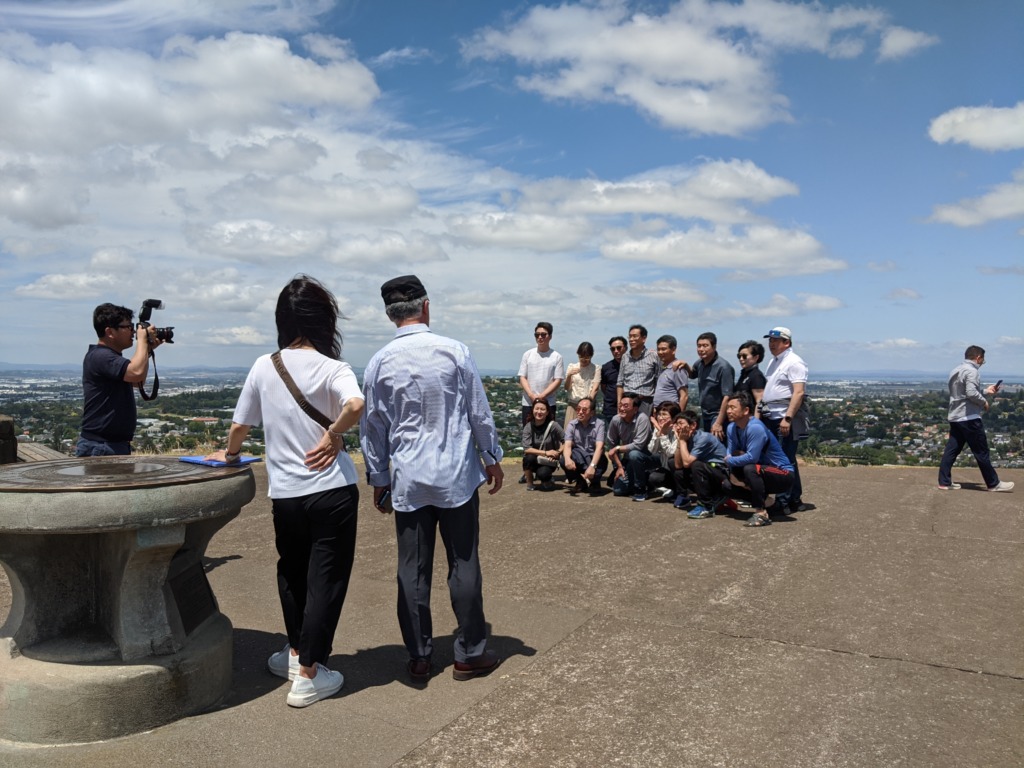
In any case, the half-day part of the tour was ending. After admiring the view for some time, we headed back to the car.
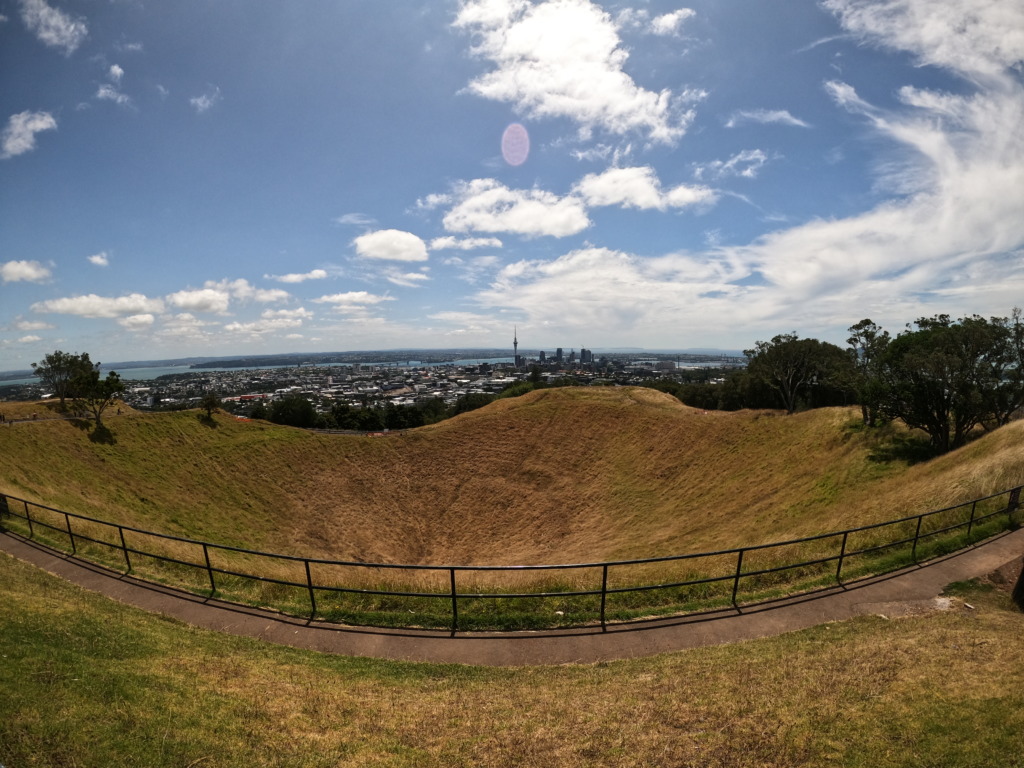
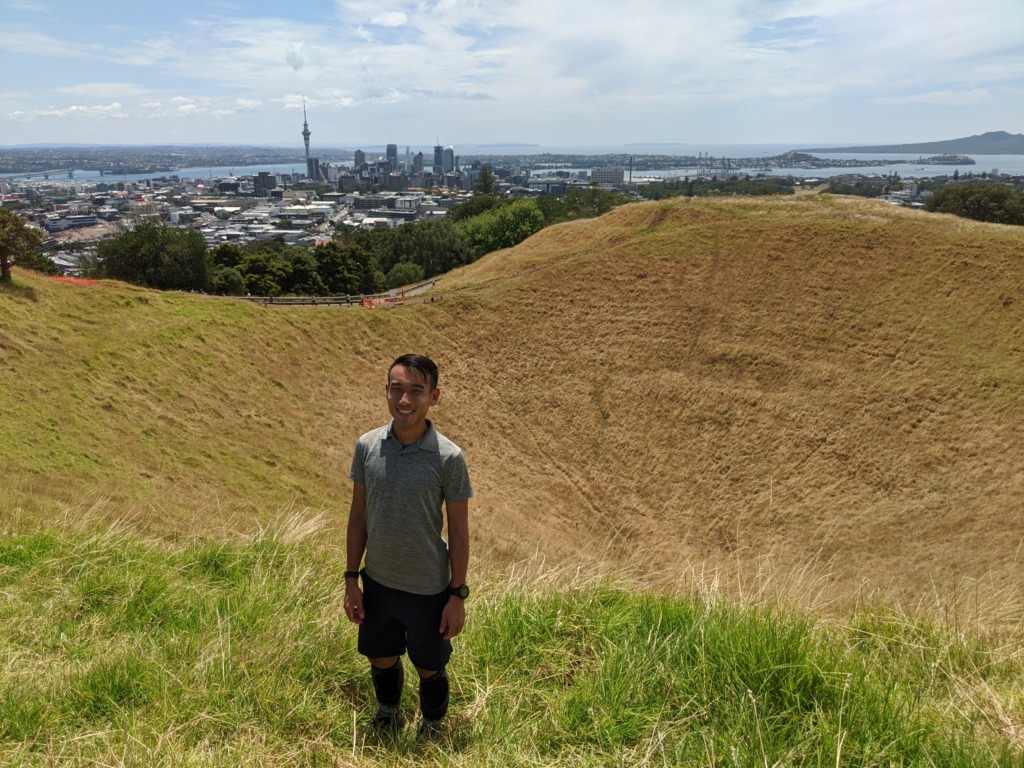
Lunch at McD’s: Kiwiburger® and Frozen Coke®
Since the Australian had only signed up for the half-day tour, Mike asked her if she wanted to stay for the second half. She had places to go, and things to do, so she declined. This mean that it’d just be me and Mike for the second half!
After dropping off the Australian, Mike asked me what I wanted for lunch. I really had no preference. “Wherever you’d normally go!” I replied.
When I asked Mike about New Zealand cuisine earlier, he had mentioned something called the “Kiwiburger.” Of course, I had never heard of it, it had the word “kiwi” in it, and it would have beetroot in it. I had to try it!
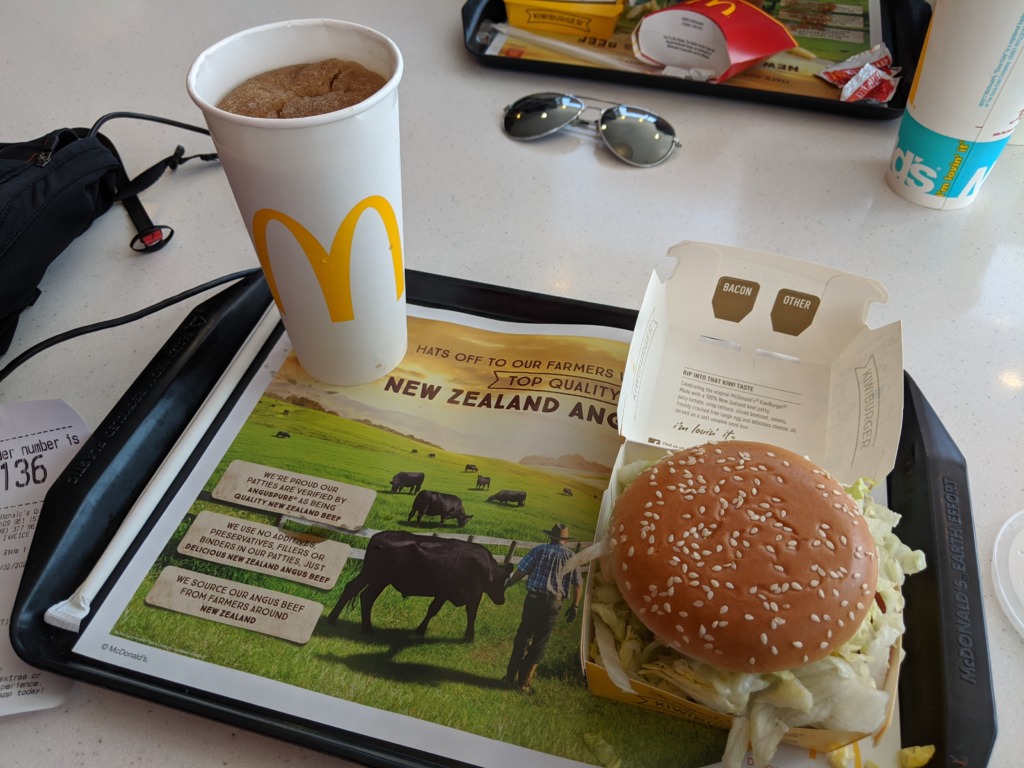
In addition to the Kiwiburger, I also had to try Frozen Coke.
So we drove to the one place where we could get these: McDonald’s.
Now, I normally never eat fast food. But I make exceptions, most recently when I visited Wendy’s at their flagship restaurant near their headquarters in Columbus, Ohio, with some of the management team I was working with. I also make exceptions when I travel abroad, most notably in Japan.
This was another exception.
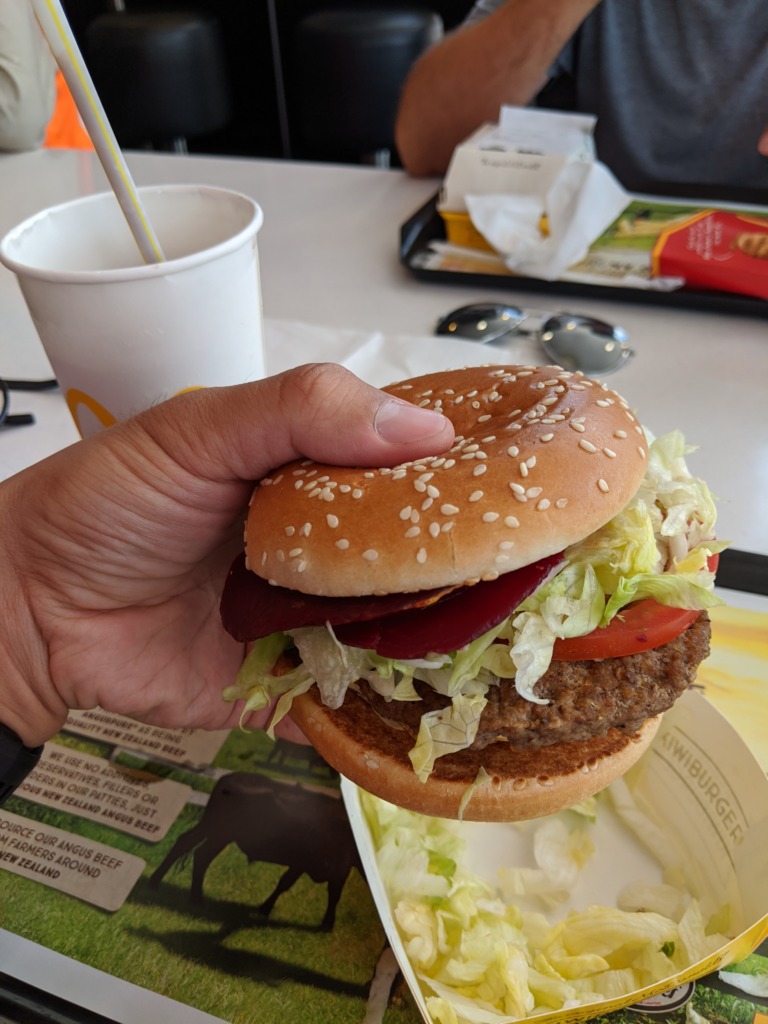
And surprisingly, it was a pleasant exception. I pretty much hate having any burger at any fast food joint (other than In ‘N Out and maybe Five Guys and Smashburger), but I thought the beef actually had texture and flavor, the bread actually fresh and doughy, and to top it off, the beetroot definitely added a great X-factor. I’d have it again (but not too often, especially as I continue to reduce my meat consumption).
As for the Frozen Coke… it was not bad. It was not the best either. It definitely reminded of me maybe a stronger-flavored slushie from a typical American 7-11. It wasn’t as sweet as I feared (though apparently it contains over 20 teaspoons of added sugar — yikes!)… but I think I’d skip it next time.
As we ate, I asked Mike how he got into tour guiding (I always ask guides this question — I’ve known literally just one person who’s ever told me that he wanted to make tour guiding his career after college).
Without getting into too much detail, he had gone to school for industrial engineering, and had worked in the field for some time. But as his field changed, he had to move to a new company, that didn’t treat him well. So he left. During his downtime, he picked up an interest in learning more about his country. As he learned more, he decided to share his interest and knowledge with others, which led him to starting a tour guiding business.
It was unclear to me how long he’d want to continue this business. But I was glad that I had chosen to support a local small business by (1) booking a tour with him, and (2) directly booking through his “backend” scheduling site at rezdy.com, rather than through a referral or aggregate site like TripAdvisor (he was happy to hear this since TripAdvisor and sites like them take a huge cut!).
In any case, as we wrapped up lunch, it was time to head to our first non-volcano destination.
One Comment